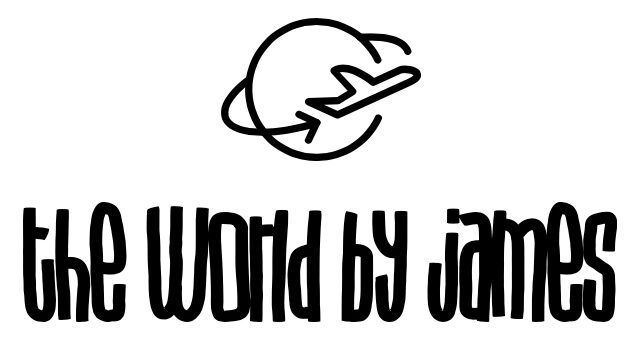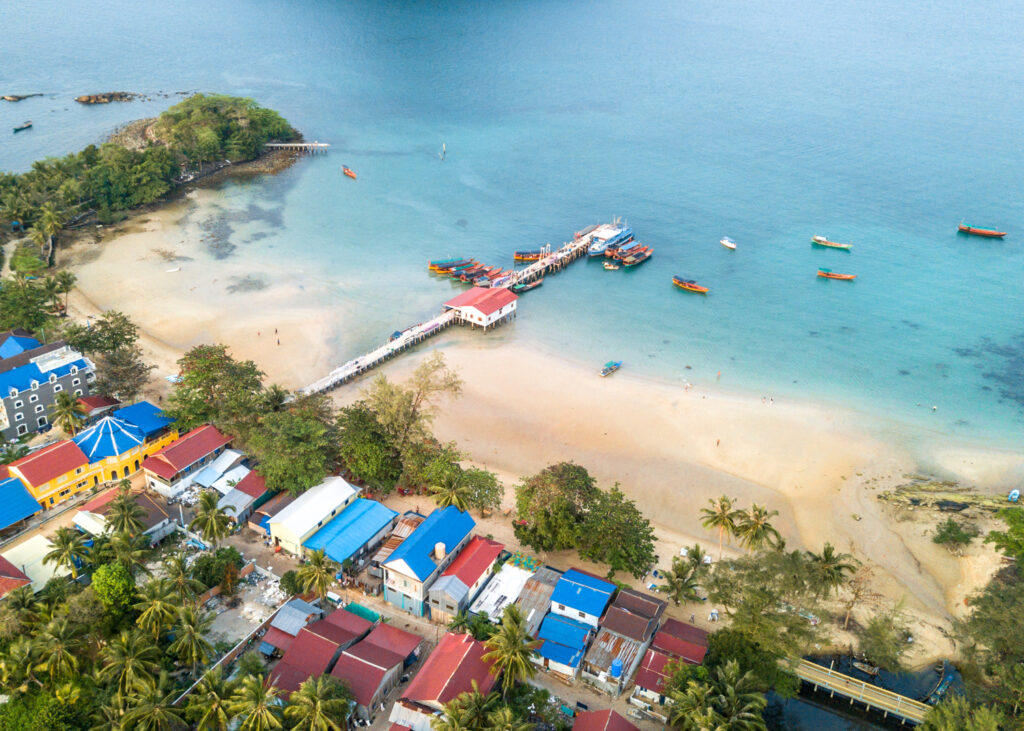Disclosure: This post contains affiliate links that I may earn a small commission from if you purchase something through them. This comes at no extra cost to you!
One of the most popular backpacking destinations in the whole world, Cambodia is packed with bucket-list locations and unique things to do.
It’s a super budget-friendly country with well-connected and affordable transport links as well as stunning natural landscapes, ancient mysteries, cultural gems, tropical beaches and delicious cuisine.
With 2 weeks here you’re sure to have the time of your life, but you’ll also likely experience a whirlwind of emotions due to Cambodia’s fascinating, albeit saddening, recent past. The kids smiling and waving at you as you zoom past rural villages are sure to put a grin on your face, but the harsh reality of one of the darkest movements in world history will wipe it off pretty quickly. The effects of the brutal Khmer Rouge regime in the 1970s are still very raw continue to haunt the people today. If you’re into ‘dark tourism’ as I am, you’ll be interetsed to learn about the barbaric regime which is all too recent.
There’s more to Cambodia than just Angkor Wat! Every kind of traveller will find something awesome to do here, which is probably what made it so popular in the first place! This itinerary will take you from Siem Reap to Phnom Penh while visiting the best bits of the country over 2 weeks, including helpful tips, transport suggestions, useful information and photography from my trip.
Table of Contents...
Toggle
Useful information for Cambodia
- Capital: Phnom Penh
- Language: Khmer
- Population: 16.6 million
- Currency: Cambodia uses two currencies, USD and Cambodian Riel. You can pay in either, although USD is more common. If you buy something in USD that costs less than $1, you’ll get your change back in Riel. £1/$1 = 5100/4100 Riel.
- Visa info: Most nationalities can get a visa on arrival at a Cambodian air or land border. The price varies but is around $30-$40 (must be paid in USD), and it is valid for one month.
- SIM Card info: I highly getting a SIM card for your travels in Cambodia. This means you can use apps like Grab for cheaper taxi fares but it also means you’re always connected to the world, never needing to rely on WiFi. Metfone, Smart & Cellcard are the three options and all have good coverage. You can also get an E-SIM on Get Your Guide which is valid in more than one country. Choose your plan here.
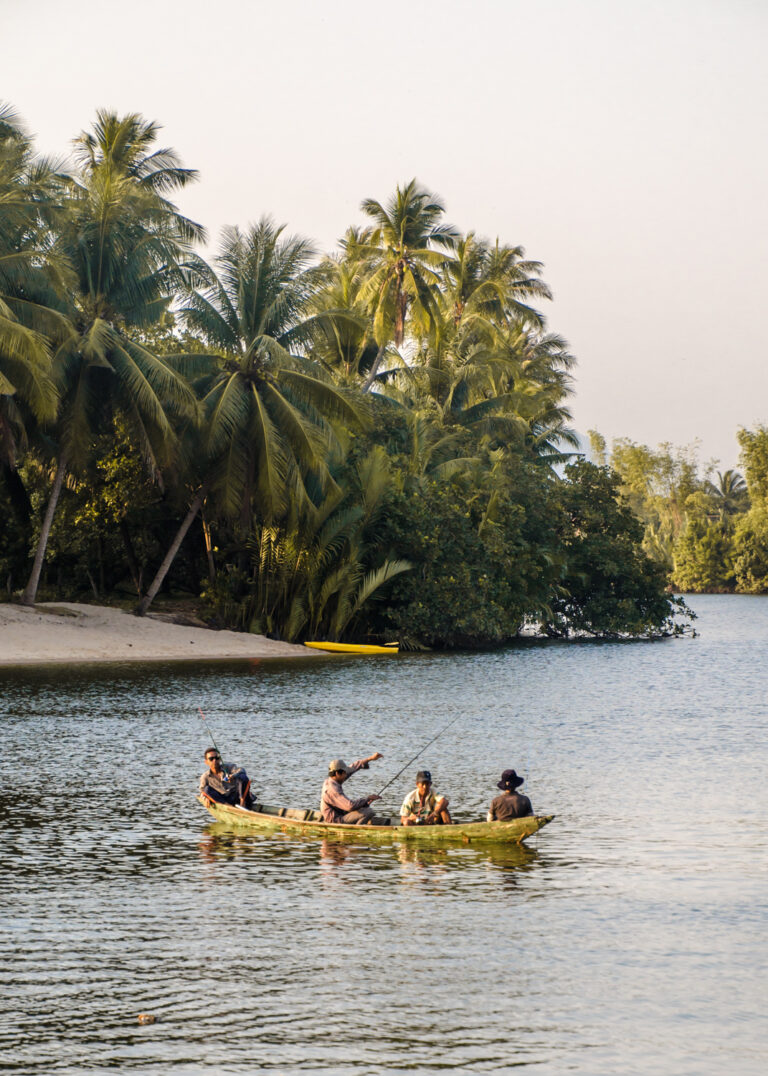
How to get here
- Flight: Cambodia has 3 international airports: Siem Reap, Phnom Penh and Sihanoukville and you can sometimes find flights from neighbouring countries like Thailand, Laos and Vietnam for less than $100 on Skyscanner – the best resource for airfares. Although quick and efficient, this is the most expensive way to travel to Cambodia by far.
- Bus: There is an abundance of potential entry points to Cambodia by bus. These are affordable and, although they take a long time, normally pretty comfortable. Most overnight buses have beds and curtains and are a unique experience. Most commonly you can catch night buses from Ho Chi Minh (Vietnam), Bangkok (Thailand), Pakse (Laos) to either Siem Reap, Phnom Penh or Sihanoukville.
12Go is the best place to book tickets. Book your bus on their website here.
How to get around
- Bus: Sleeper/tourist buses and minibuses are amazing for long journeys between destinations. For just a few dollars you can travel hundreds of miles and most accommodations will happily arrange this sort of thing for you in Cambodia. Local buses are even cheaper but I doubt you’ll want to sit on those for a 10 hour ride! I recommend just using local buses for short journeys. To book a tourist bus ahead of time, 12Go is the place to go for the best deals.
- Grab: In the cities the best way to get around is Grab, which is Asia’s version of Uber. Have the luxury of an air conditioned car across the city to escape the sun, and best of all – a ride will only cost you a few dollars. To use Grab all you need is a local SIM card and then you can use the card payment option which is great so you never have to fiddle around with cash. Top tip: Taxis are hot-spots for scams so make sure, if you do get one, you only get a metered one or agree on a price beforehand.
- Tuktuk: Tuktuks are normally cheaper than Grab and are another great way of getting around cities. You’re never too far from one in Cambodia, but just make sure to negotiate a price beforehand.
- Motorbike: Driving a motorbike or scooter is an amazing way to get yourself to more rural areas of Southeast Asia. If you plan to do a lot of exploring one day, this will work out as the cheapest option when compared to tuktuks and Grab. I wouldn’t advise renting one in busy cities like Phnom Penh though, not without prior experience.
- Tours: Another way of getting around if you’re pushed for time but want to see the sights efficiently is by taking a tour with a local guide. You can choose single day tours of multi-day tours – it’s up to you! These are the best companies for tours:
When to visit
As with the other countries in Southeast Asia, Cambodia’s high season is the dry season of November to April when temperatures average 32c.
May to October is the wet season and humidity levels rise a lot during this time. To avoid the crowds of the high season and still get the best of the weather, I recommend visiting in either October, November, April or May.
Expected costs
Accommodation, food, transport and activities are very cheap in Cambodia, albeit a little more than its neighbouring countries like Thailand and Vietnam. Depending on your specific travel style, a comfortable daily budget would be $25-$40 per day, but it largely depends on whether you’d prefer a hostel dorm or private room, and so on.
How long to stay
To see the best of Cambodia you’ll need a minimum of 2 weeks which would allow you to spend a decent amount of time in each location. 3 weeks would be more ideal as you can spend longer in each place. When I visited Cambodia I followed this itinerary but gave myself 17 days instead of 14.
Your visa will likely be for 30 days, so you could easily add places to this itinerary and stay for another 2 weeks after you’ve seen the best bits.
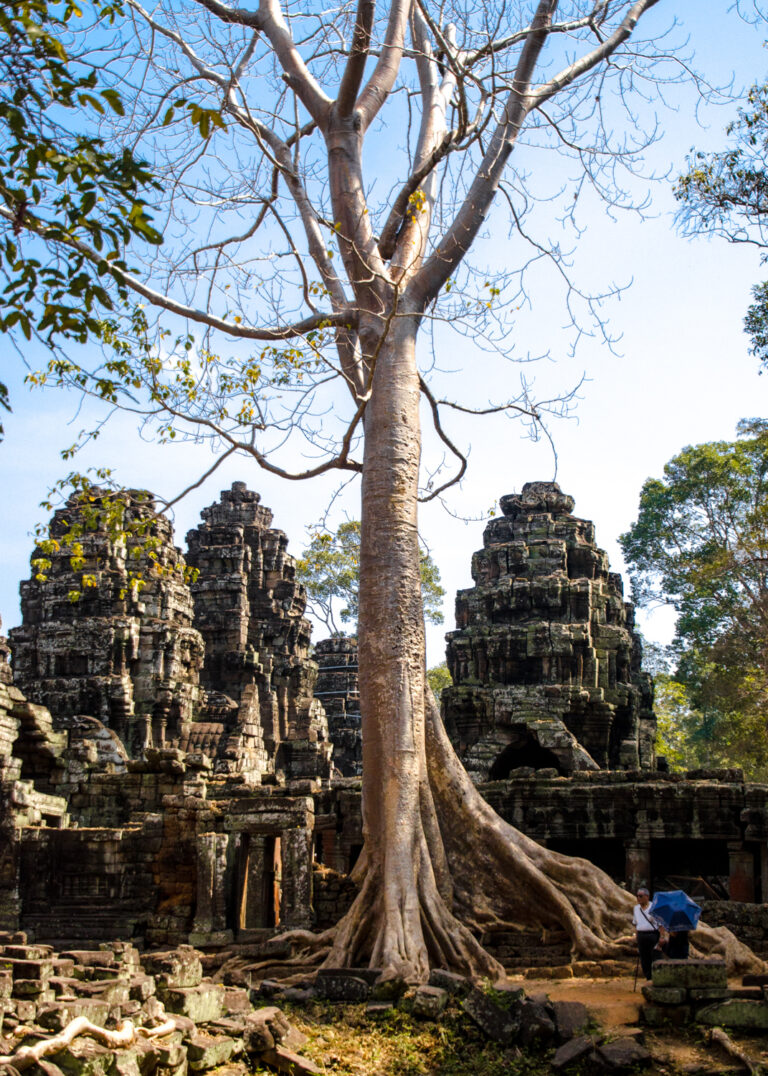
A brief history of Cambodia
The Khmer Rouge, meaning ‘Red Cambodians’, was a communist movement that overthrew the Cambodian government in 1975 and seized power of the country. For the next four year they began one of the most brutal and inhumane massacres of a population in world history.
Under orders from leader Pol Pot and funded by the Chinese Communist Party, the Khmer Rouge slaughtered 25% of the entire population of Cambodia in order to ‘start fresh’. Pol Pot wanted to create a self-sufficient agrarian country, meaning city people were forcibly transported to rural areas to work in labour camps in brutal conditions where malnutrition, torture, rape and murder were rife. In total nearly 2,000,000 lives were lost in just 4 years.
Innocent people were imprisoned and tortured at Tuol Sleng Prison in Phnom Penh (now the S21 museum) until they confessed just to make the pain stop. Then they were taken to one of over 20,000 killing fields to be mercilessly executed and buried in shallow mass graves.
To learn more, read my full guide to visiting Phnom Penh’s genocidal sites here.
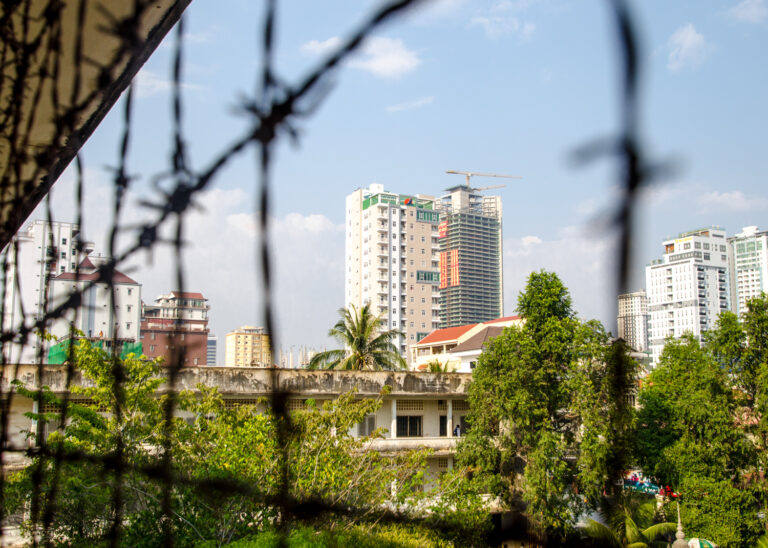
2 week Cambodia itinerary
Here’s my ultimate 2 weeks travel itinerary for Cambodia, including essential information, tips, photos and helpful links to Google Maps locations.
Itinerary breakdown:
- Days 1-3: Siem Reap
- Days 4-5: Battambang
- Day 6: Sihanoukville
- Days 7-9: Koh Rong Samloem
- Days 10-12: Kampot & Kep
- Days 13-14: Phnom Penh
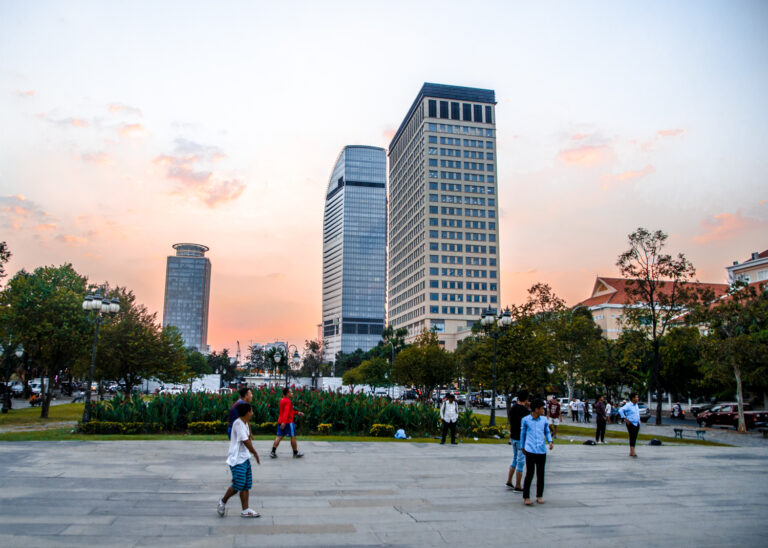
Days 1-3: Siem Reap
Cambodia’s second largest city is a convenient base for exploring the world famous temples of Angkor Wat, but make sure to dedicate at least one day to explore the city itself.
Where to stay:
- Best hostel: Bokre Angkor Hostel
- Best mid-range: Hello Cambodia Boutique
Day 1: Arrival day in Siem Reap
Spend your arrival day getting your bearings in Siem Reap and organising your Angkor Wat experience for the next day.
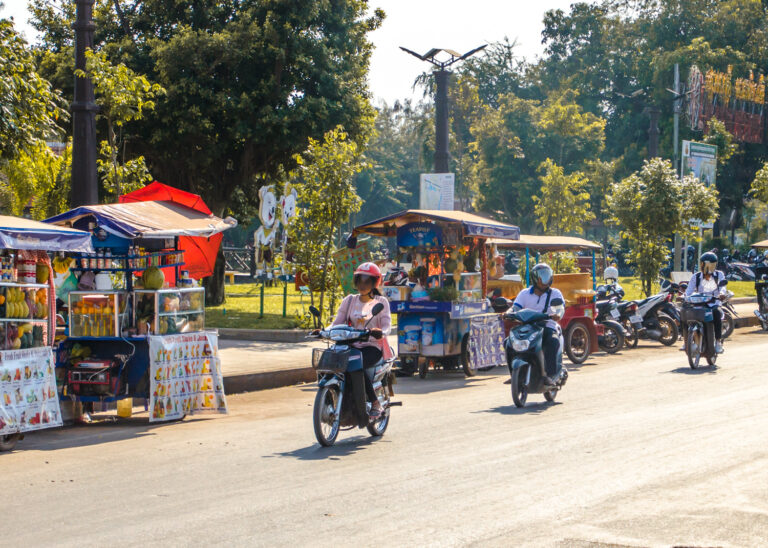
You won’t have to look hard to find a tuktuk driver willing to drive you around Angkor Wat, or alternatively you could easily book through your hostel or hotel. Everyone is happy to help in Cambodia!
Expect to pay around $20-$30 for the day, depending on your negotiation skills.
If you got an early flight or bus and have spare time, check out the amazing War Museum of Cambodia, pay a visit to the Angkor Museum, wander around the night market and have dinner from a street vendor for $1!
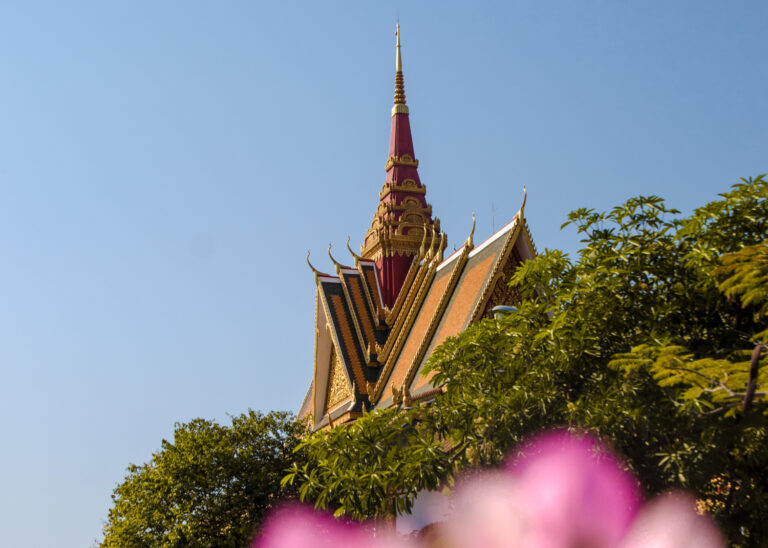
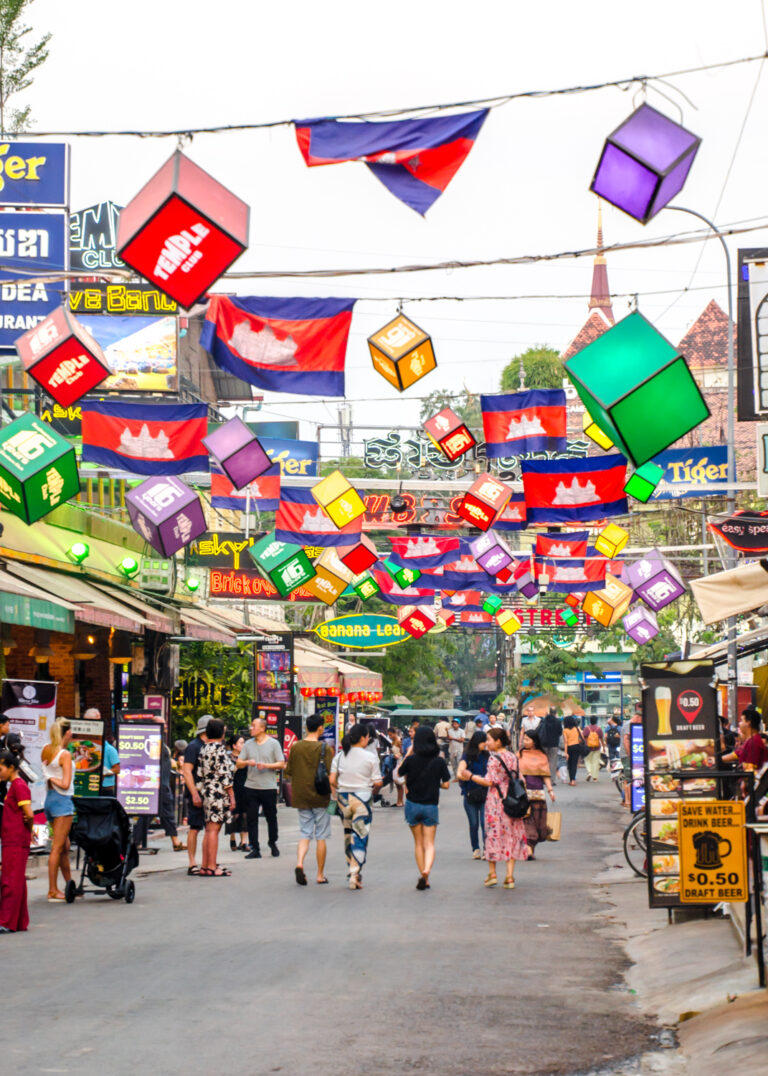
The War Museum of Cambodia
The war museum is excellent and explains all the fundamental parts of Cambodia’s involvement in the Vietnam War, as well as information on the Khmer Rouge regime and other aspects of its horribly dark past. You also get a hands on experience with some weapons, grenades and tanks, which is pretty cool!
Located near the airport, you can catch a grab for just $1.50. Entrance is $5.

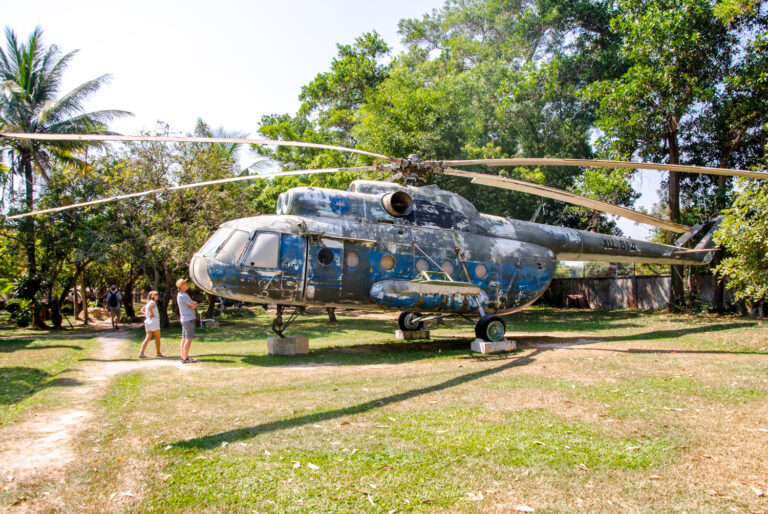
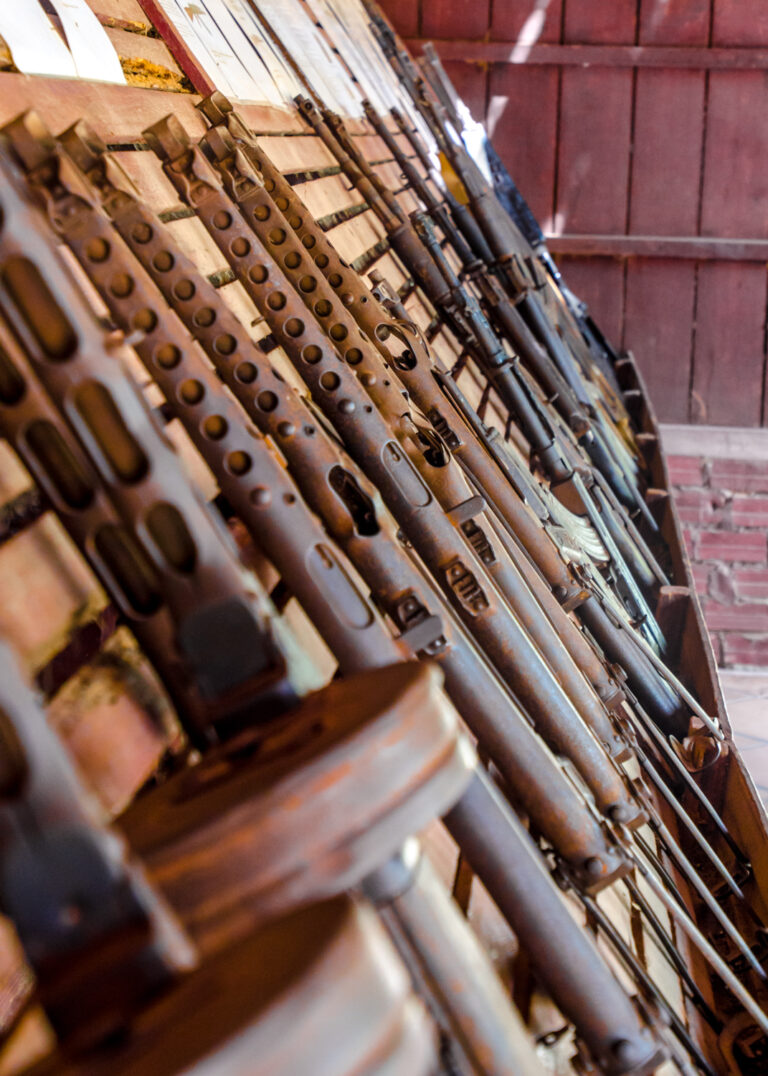
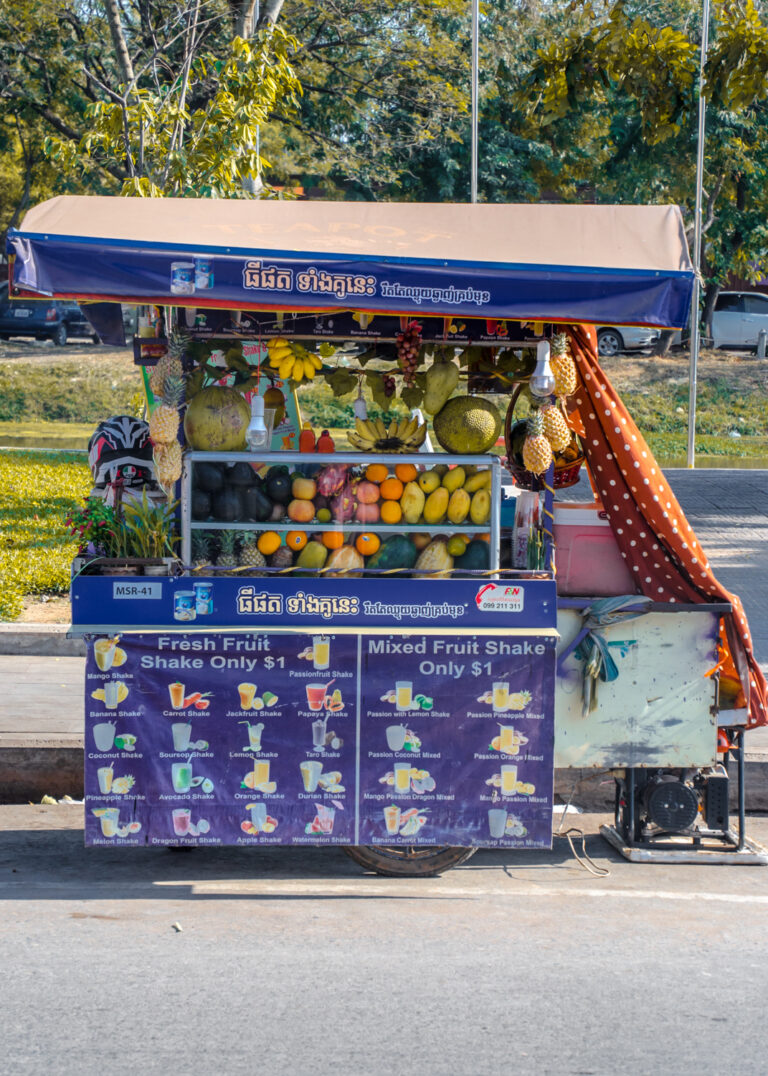
Days 2 & 3: Angkor Wat
Angkor Wat is the largest religious site in the world and the 400 square kilometre area attracts more than 2 million people every year.
You can get a 1 or 3 day pass for $37 or $62, but any longer than that is probably too much. Each day you’ll do about 6-8 hours of pure temple chasing, so it’s understandable if you’d rather just do one day.

Sunrise at Angkor Wat is commonly referred to as one of the most beautiful sunrises in the world, and the secret sure got out! Wake up early (4am) and find a spot in front of the reflection pond (the most popular place) to watch the sun slowly peak over the silhouette of Angkor Wat before you start exploring.
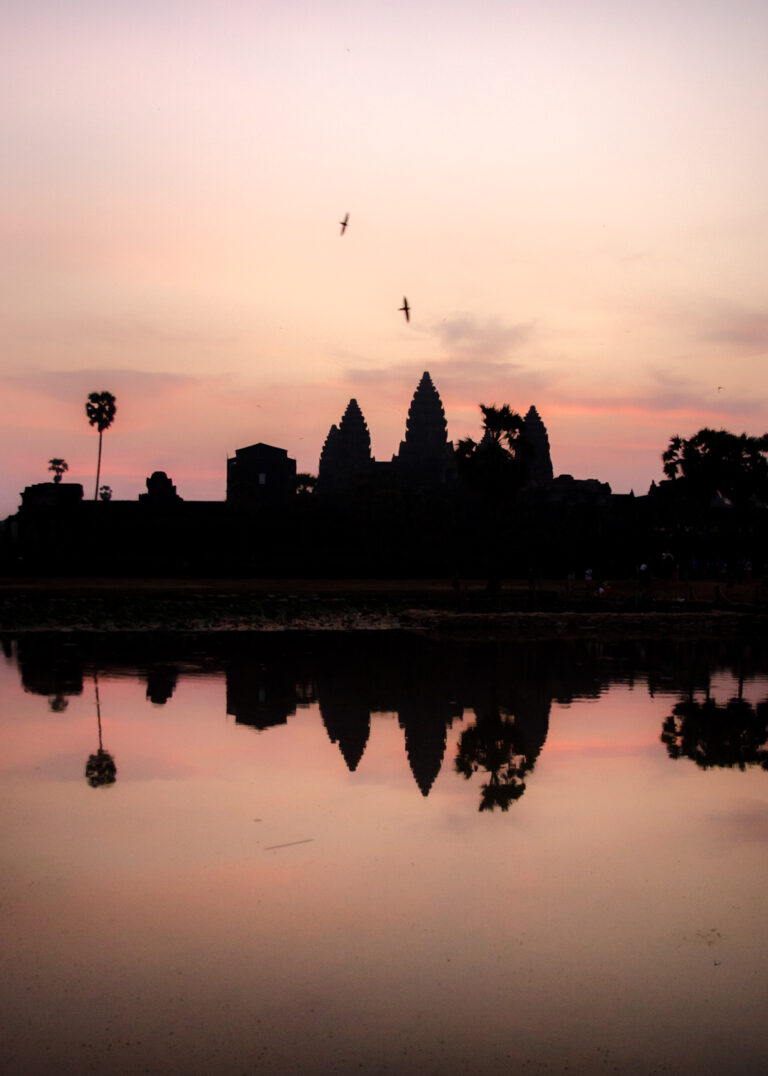
There’s so much to see here at Angkor Wat, from the famous Tomb Raider temple of Ta Phrom to the many faces carved into stone at Bayon, but it is possible to see the best of Angkor Wat in just one day if you’re willing to spend a long day out.
The temples are extremely spread out and you’ll want as long as possible at each one. You’ll be grateful to have a tuktuk with you every step of the way, that’s for sure!
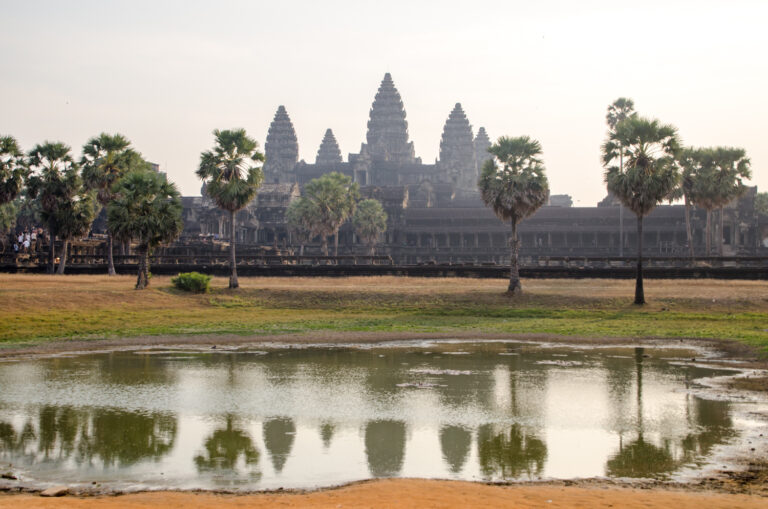
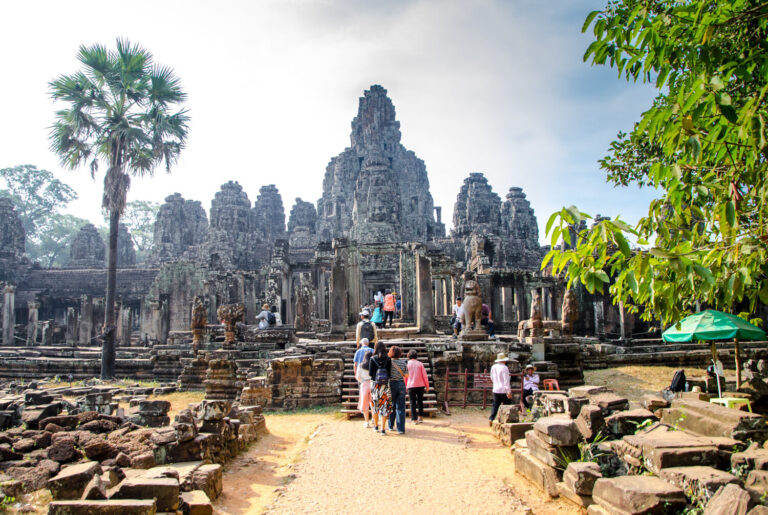
The best sites to visit are:
- Angkor Wat
- Angkor Thom (home to Bayon, Baphoun and the Terraces)
- Bayon
- Baphoun
- Terrace of the Elephants
- Terrace of the Leper King
- Preah Khan
- Ta Prohm
- Banteay Kdai
- Srah Srang
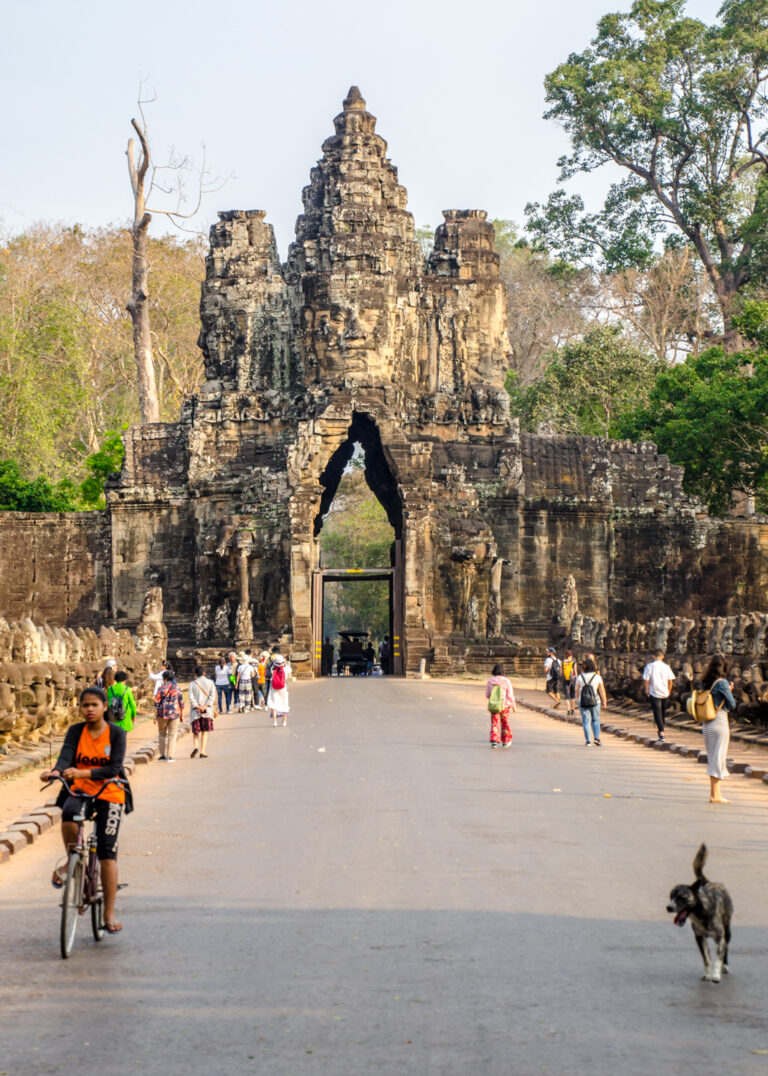

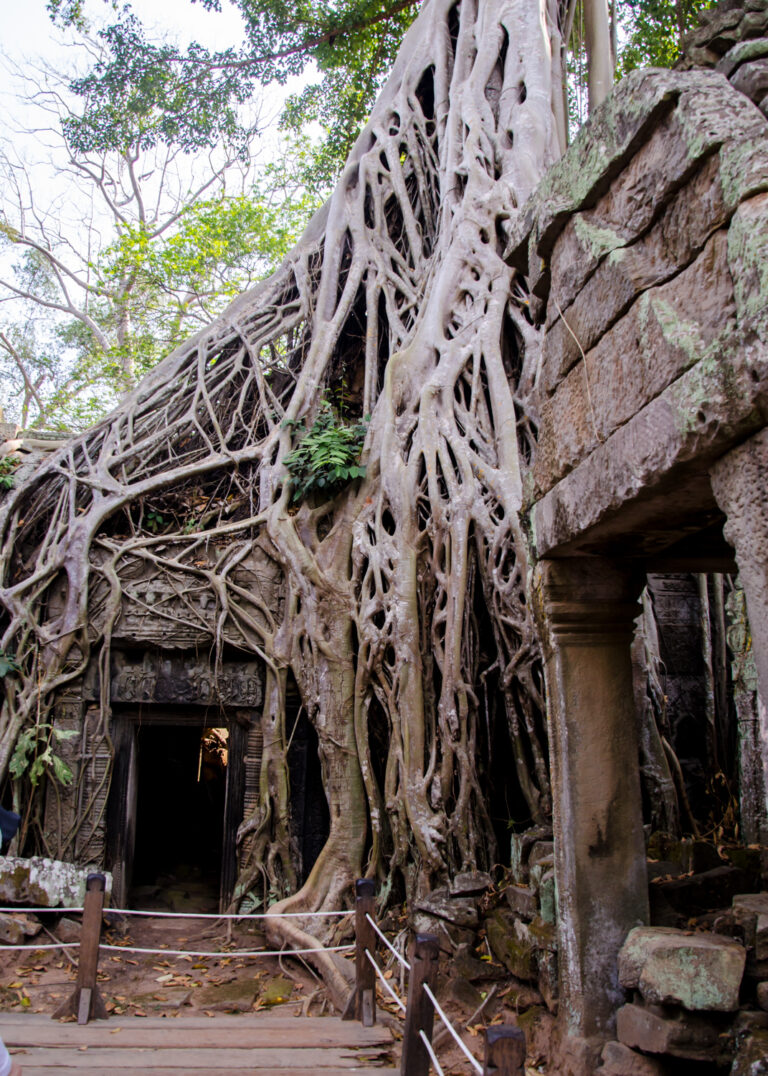
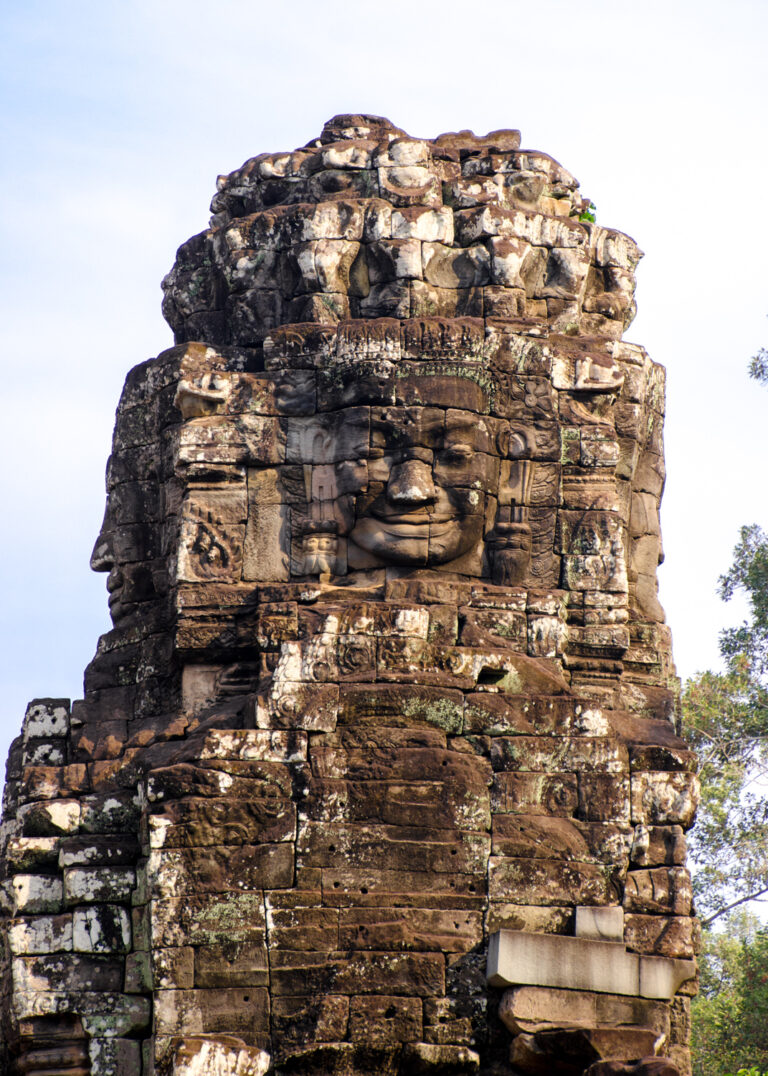
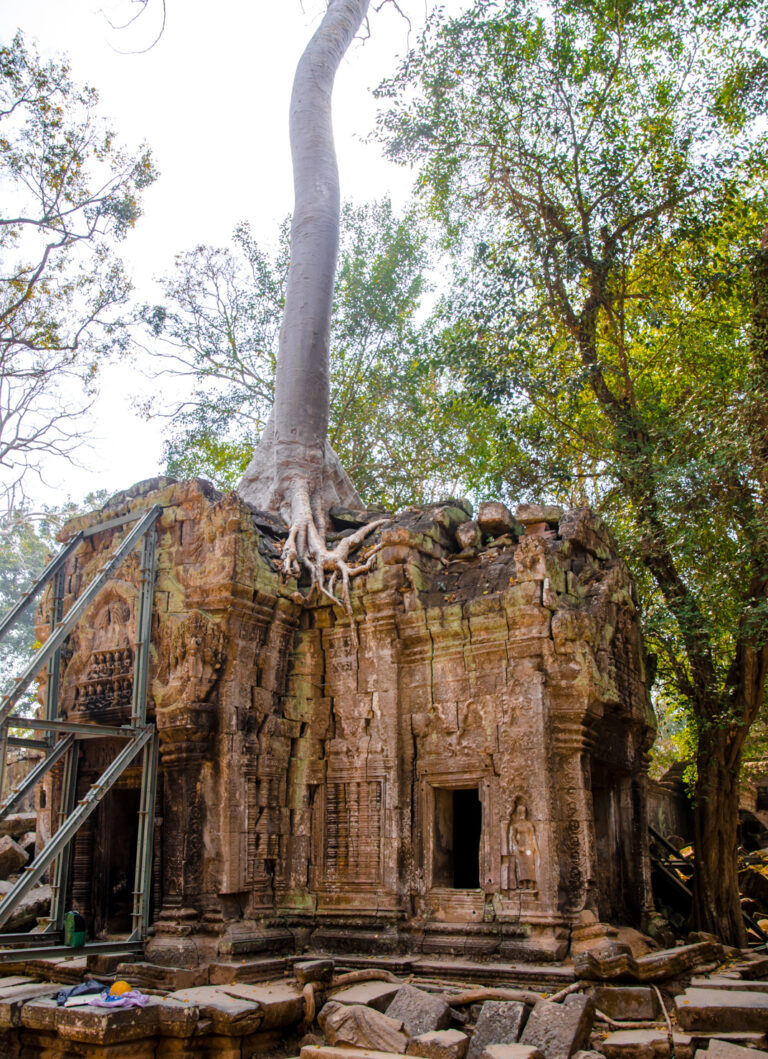
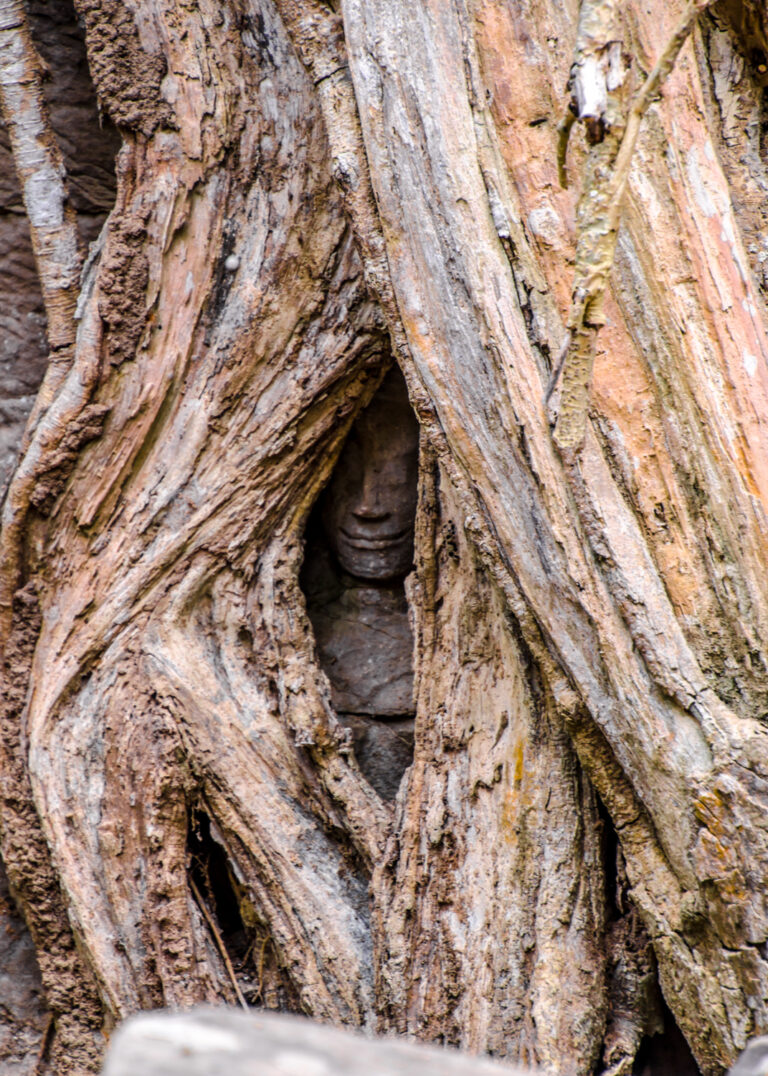
Take a local guide with you on one of these popular Angkor Wat tours:
Days 4 & 5: Battambang
Off the main tourist trail and 78km from Siem Reap is a cool little city called Battambang where our next 2 nights will be spent.
When I visited Cambodia I had a rough itinerary formed already but spontaneously added Battambang on after hearing about it from someone in Siem Reap. I think it’s always an amazing experience to see places slightly off the tourist trail and, in this case, get an insight into Cambodian lifestyle in a small city.
Where to stay:
- Best hostel: Pomme Hostel
- Best mid-range: Lotus Blanc Homestay
Search for a hostel here:
Day 4: Exploring Battambang
Rent a motorbike
First things first, you’ll want a motorbike to get from A to B efficiently here.
You can rent one for around $6 per day in Battambang from hostels and guesthouses which I highly recommend so you have freedom to roam at your own speed!
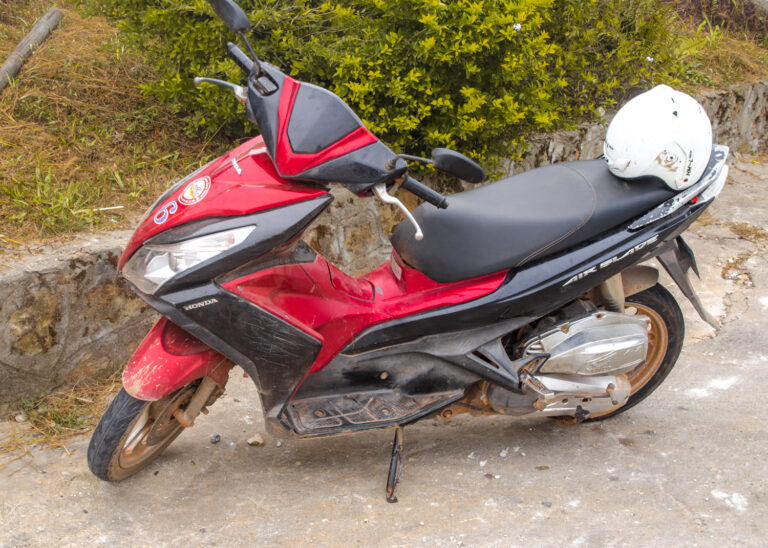
Killing Cave (Phnom Sampeau)
The Killing Cave near Battambang is a cave which, as the name hints at, has a very gruesome past.
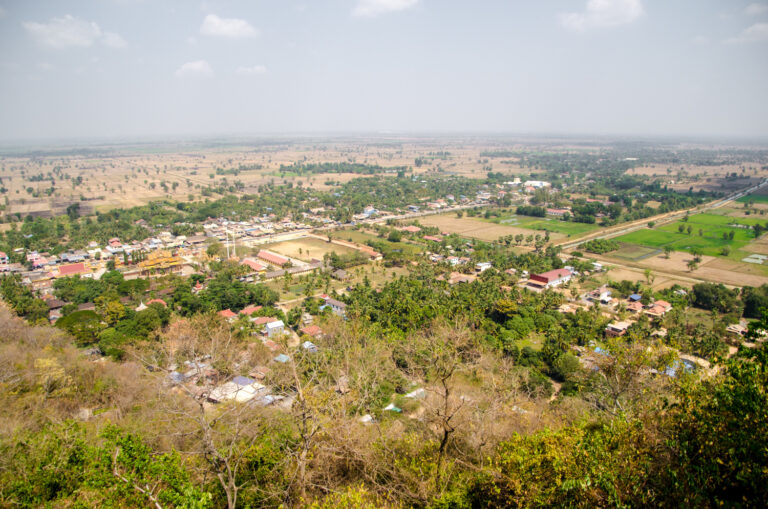
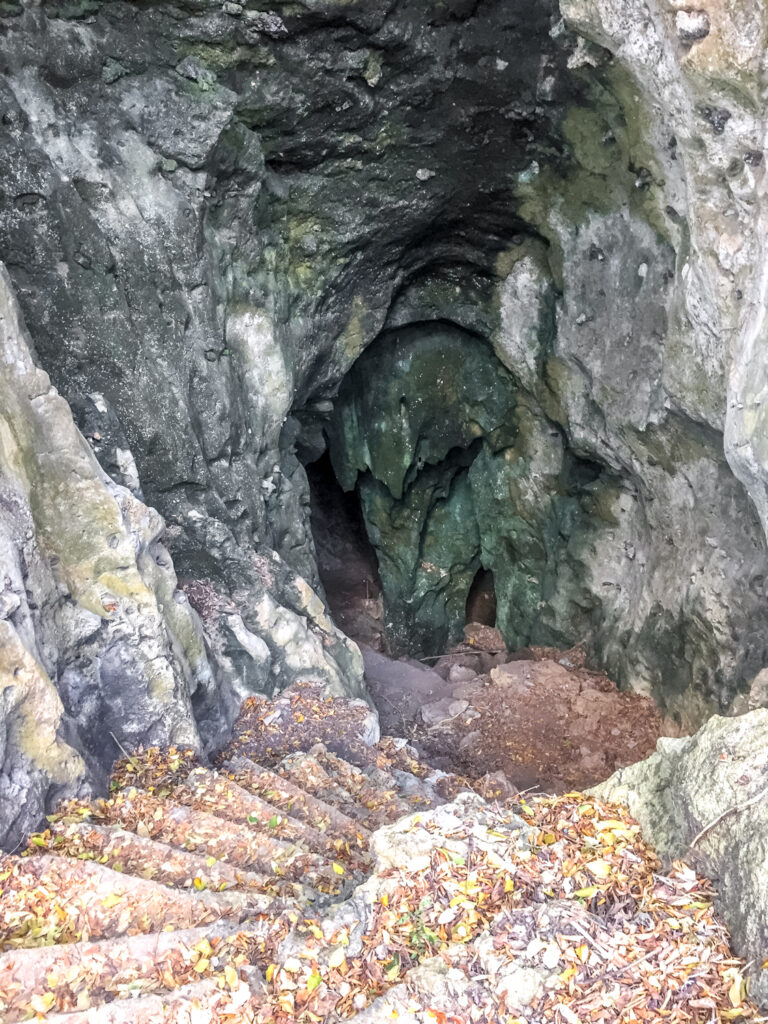
During the violent Khmer Rouge Regime, the hill (Phnom Sampeau) was used as an execution site where victims were ruthlessly murdered at the top before their bodies were thrown through a hole to the cave flow below.
Ride up the steep road for a great view over the region before you descend the set of stairs into the cave itself. There are some victim’s skulls displayed inside a glass case and a small Buddhist shrine inside, as well as a large golden reclining Buddha.
The Killing Cave is about 13km from Battambang and costs $3 to enter.
Keep an eye out for the cheeky monkeys at the top!
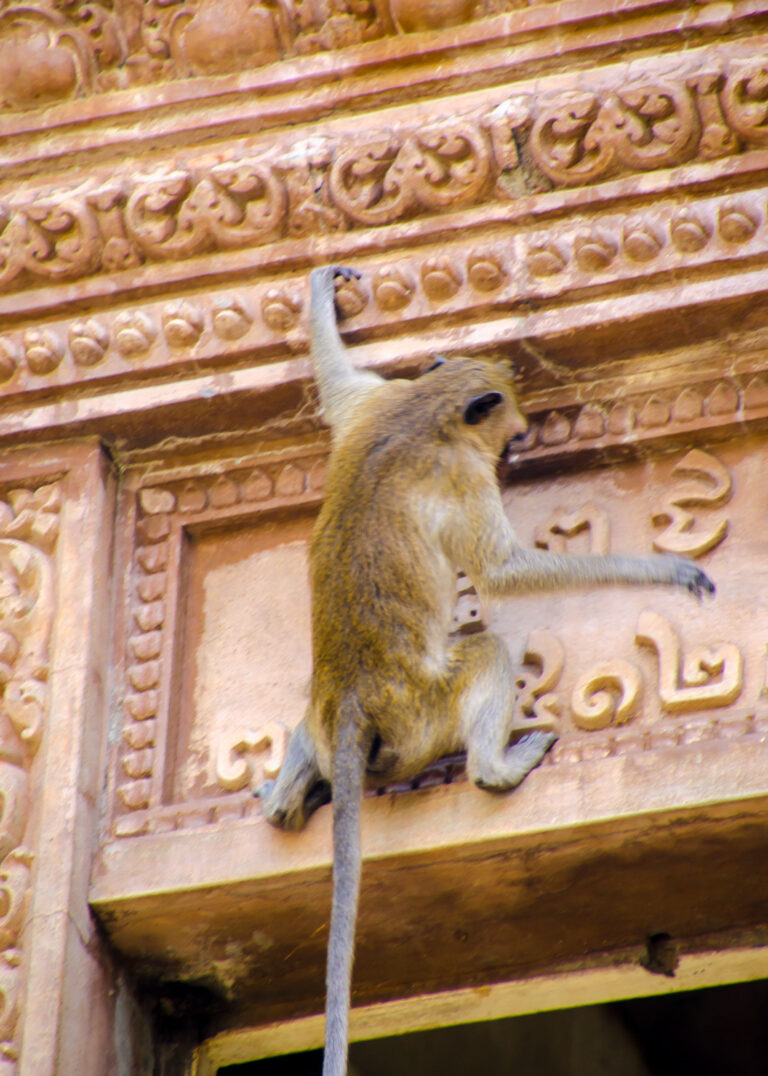
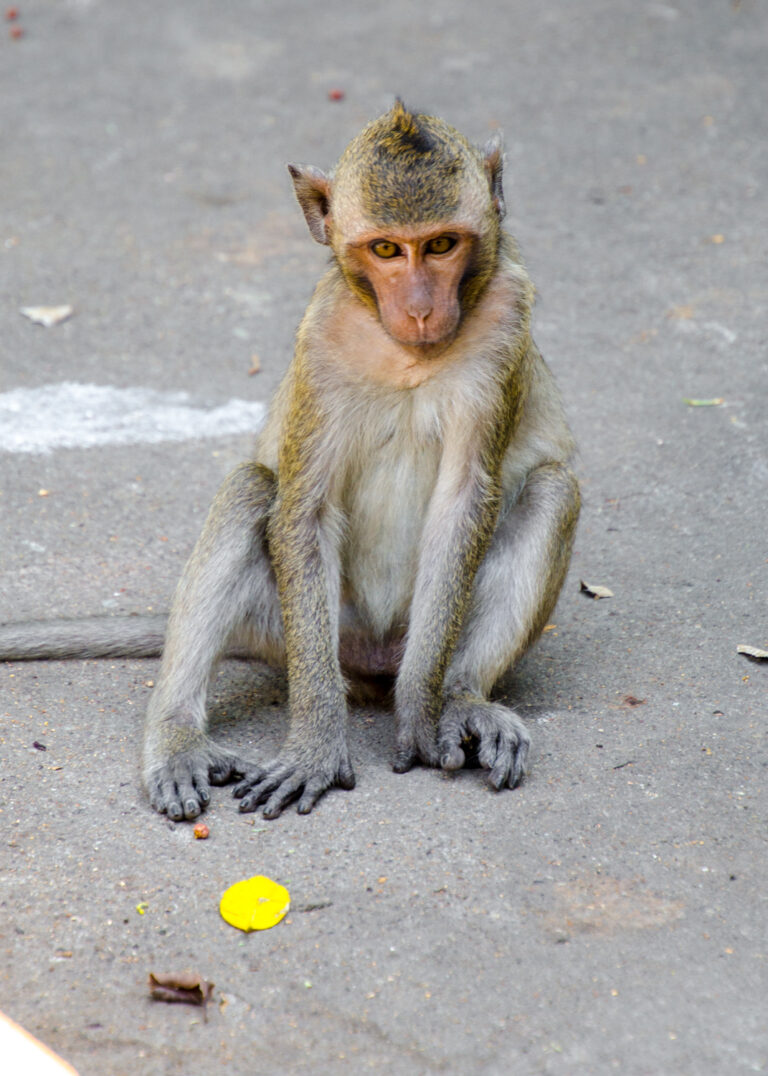
Wat Phnom Ek & Big Buddha
Perhaps underwhelming after visiting Angkor Wat, the 11th century ruins of Hindu temple Wat Phnom Ek and the Big Buddha are still well worth a look.
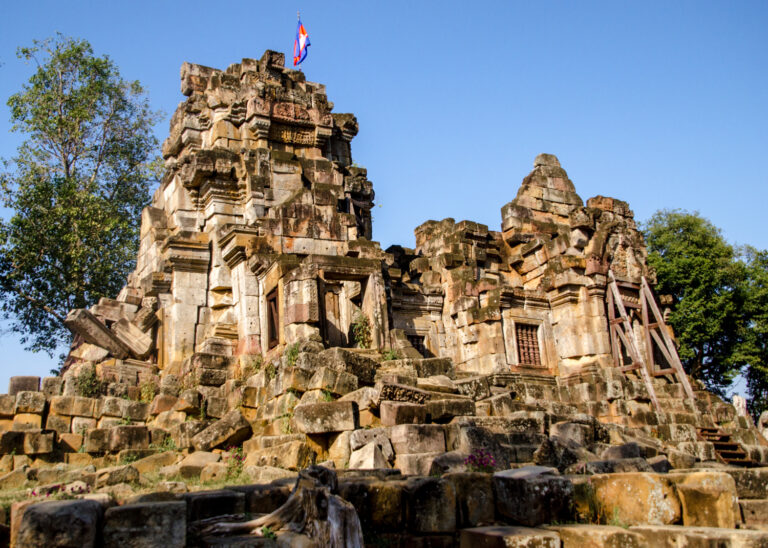
The ruins are on a 50m² area of land and the price is just $1 to explore them.
Truthfully, there isn’t a whole lot to see here, but it’s a good excuse for a rural cruise on the bike anyway! Try to imagine you hadn’t just been to Angkor Wat, and then maybe you’ll be impressed.
You can find Wat Phnom Ek about 12km from the city here.
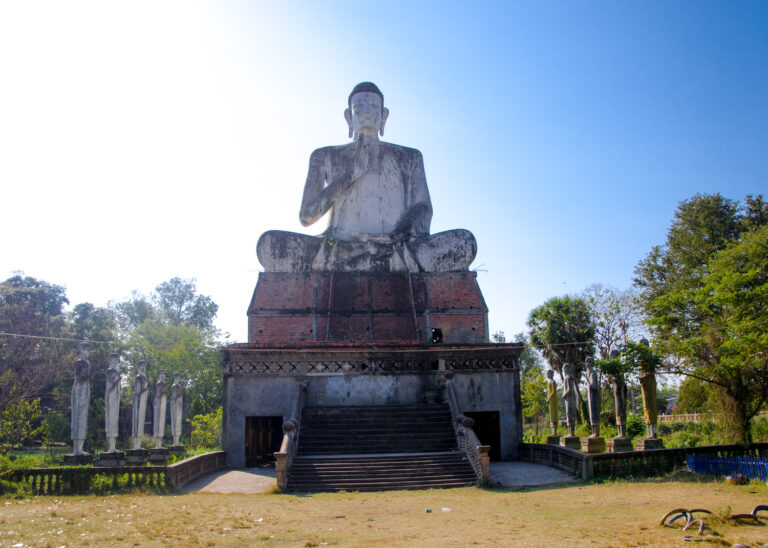

Day 4: Exploring Battambang
The bamboo train
The most well-known thing to do in Battambang is the Bamboo train, although I must admit I didn’t do it and I haven’t heard great things. Best read some TripAdvisor reviews beforehand and decide for yourself.
The tracks used to run across the country to transport goods, but now you can take rides on a short section of it. You sit on a flatbed bamboo mat where there’s space for maybe 2-4 people and take a 7km ride through the local countryside for around $10. I’m sure this would be great for children, but apparently not so much with backpackers.
The train then stops at the other end for 10 minutes and its widely reported that you get swarmed by kids trying to sell you stuff before heading back.
Thinking of visiting Southeast Asia soon? Don’t miss these essential guides to help planning your trip:
Spend the rest of the day walking around the markets and streets of Battambang before arranging your bus for the next day.
Alternatively, jump on a group tour.
Day 6: Bus to Sihanoukville
The bus from Battambang to Sihanoukville takes around 17 hours as you’ll have to swap buses in Phomn Penh like I did. It’s a savage journey, but at least you save money on a night’s accommodation, right?!
During my trip, I left Battambang at around 6am and didn’t arrive at the hostel in Sihanoukville until about 1:45am. Mistakes were made!
The best place to check bus times and prices in Asia is 12Go.
Where to stay:
- Best hostel: Onederz Sihanoukville
- Best mid-range: Garden Bungalow
Sihanoukville is the gateway to the islands and is, unfortunately, impossible to avoid.
I’m not going to sugar-coat this at all – Sihanoukville is a total shit-hole. It was one of my most disappointing travel experiences ever because, long story short, the Chinese mafia have overrun the city and turned it into a dirty Las Vegas-type place. Even the local Cambodian people have been driven out! It also feels very unsafe and the amount of pollution in town is outrageous.
Anyway, enough ranting. My recommendation? As soon as you arrive, leave (or hide in a nice hostel for the night). If you can, accept one of the tuktuk offers when you get off the bus and head straight to the pier to catch a boat to Koh Rong or Koh Rong Samloem.
I had to spend a night here to wait for the boats in the morning and stayed at ?? which was a good hideout from the vile city.
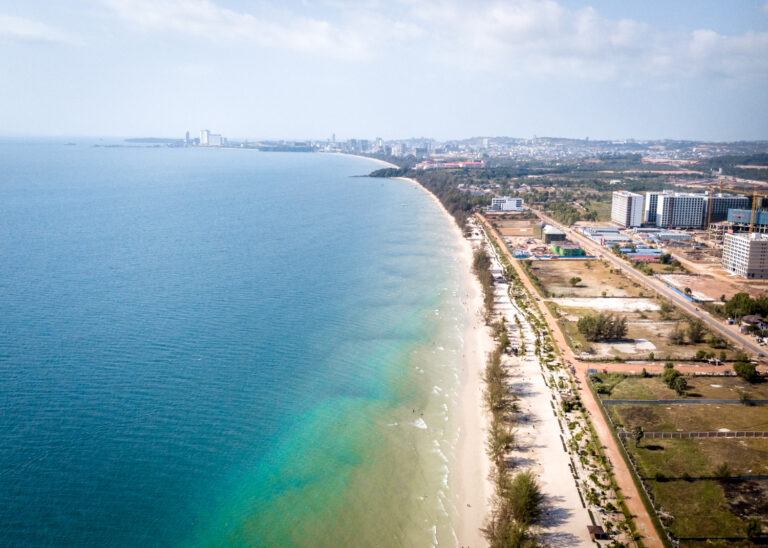
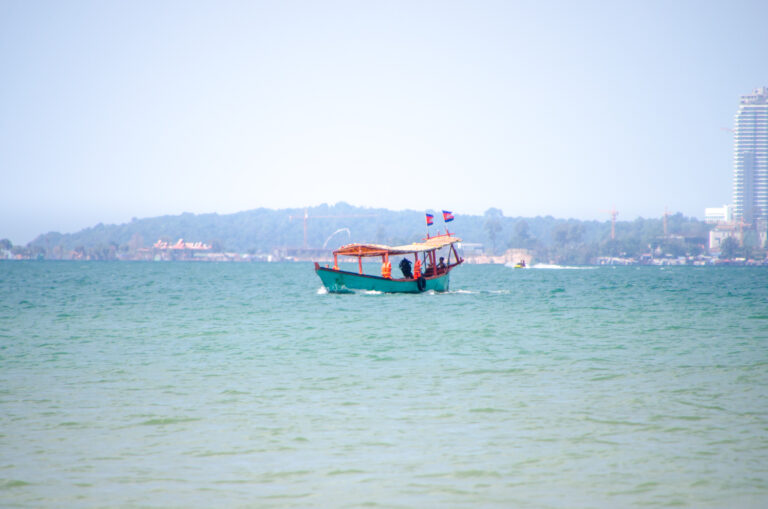
Days 7-9: Koh Rong Samloem
25km off the coast of mainland Cambodia lies Koh Rong Samloem, the little brother of neighbouring and much busier island Koh Rong. For a quieter slice of heaven, I recommend Koh Rong Samloem. For more social and party scene, head to Koh Rong.
Where to stay:
- Best budget: The Cliff Hostel, M’Pay Bay
- Best mid-range: Baloo Guesthouse
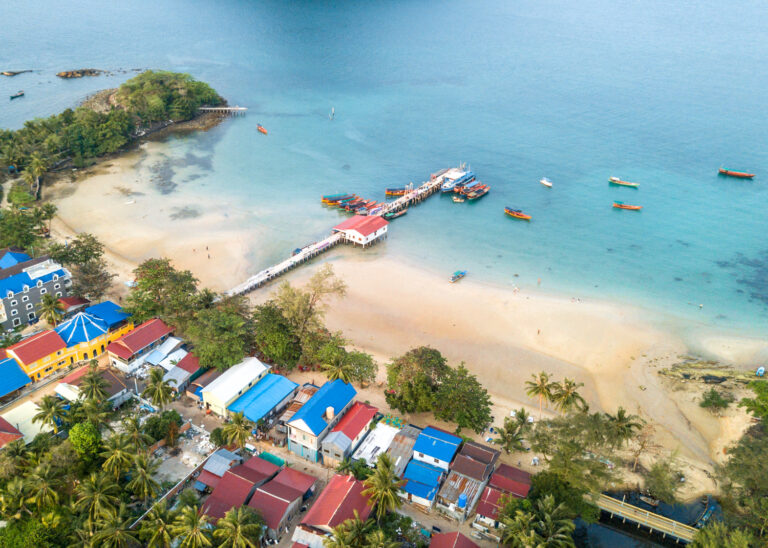
Saracen Bay is the backpacker hub of Koh Rong Samloem and is its biggest town. I stayed in M’Pai Bay on the north of the island where there is a more relaxed vibe and enough accommodation, food and drinks options to keep you going.
Alternatively, you could split your time across both Koh Rong islands and get the best of both worlds. Boats between the two islands run daily.
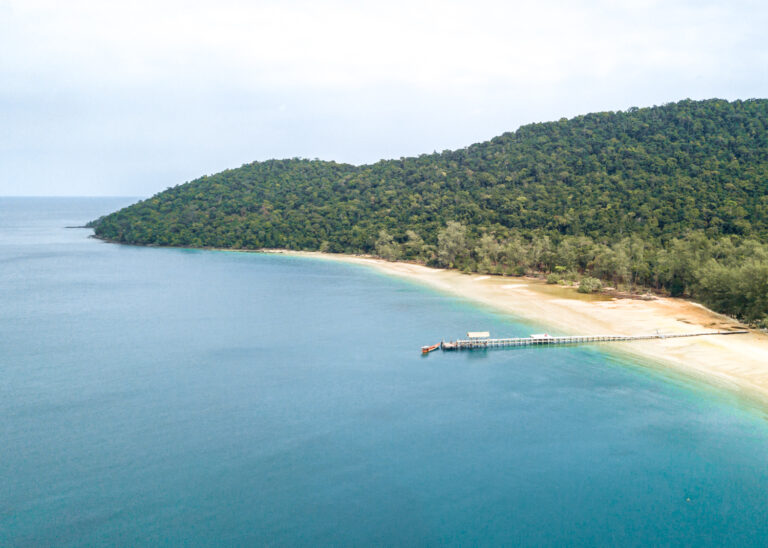
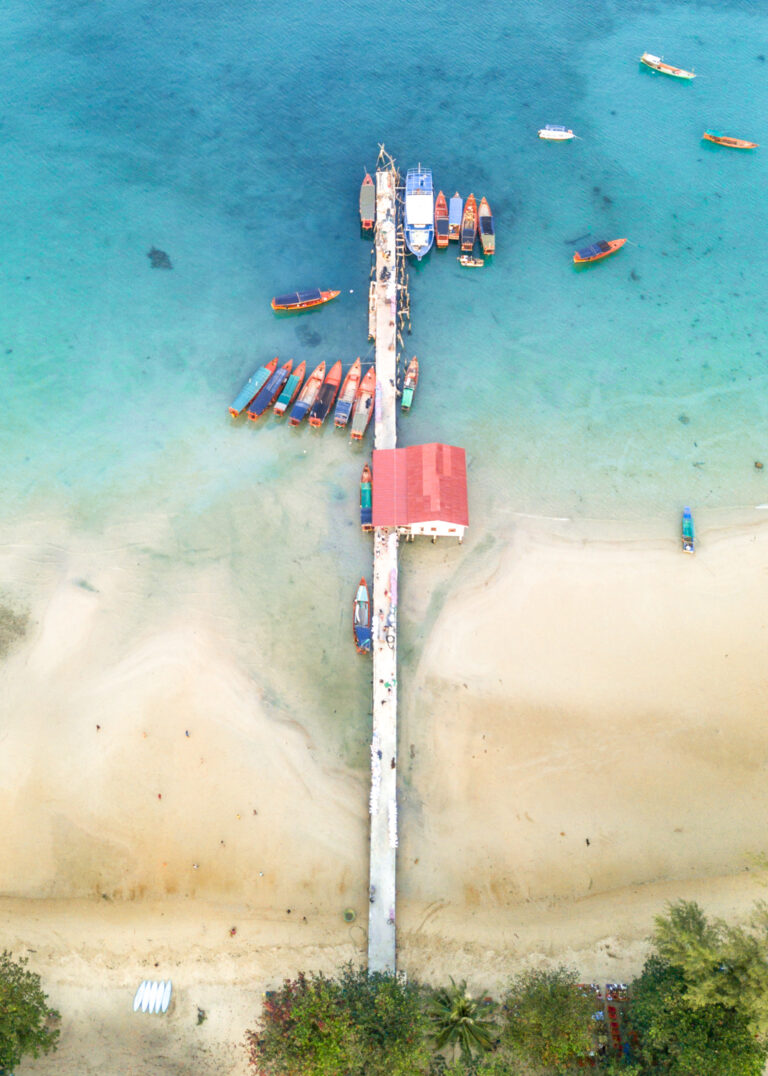
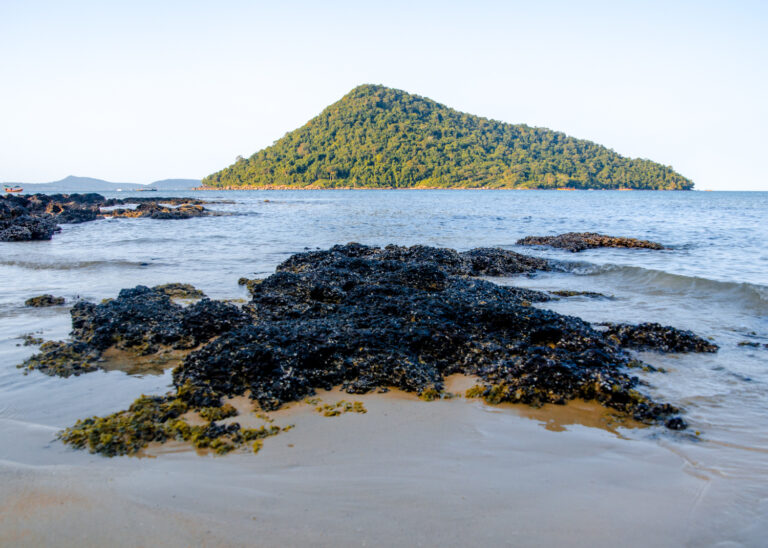
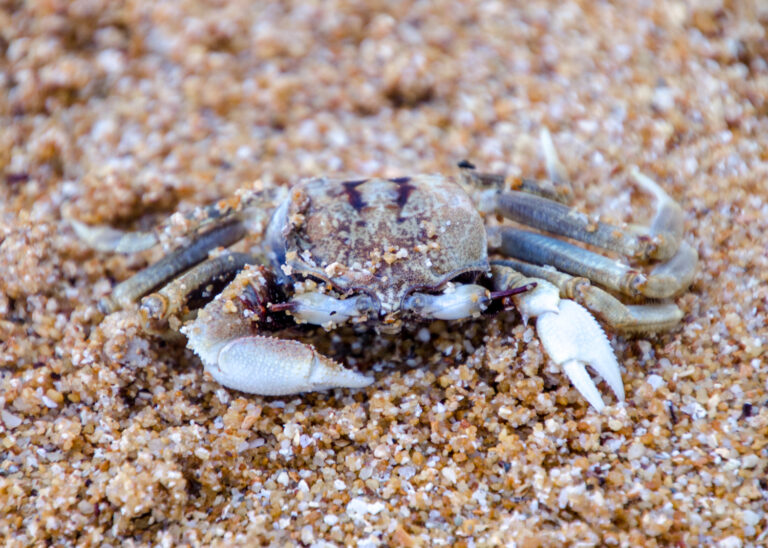
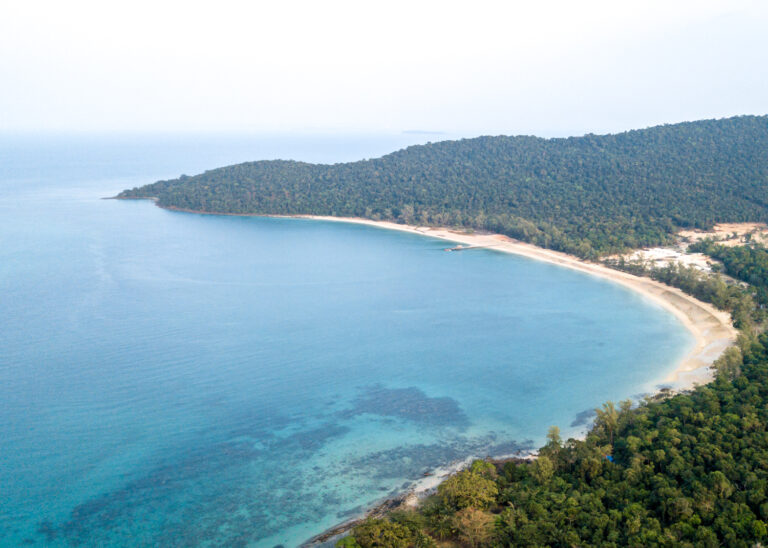
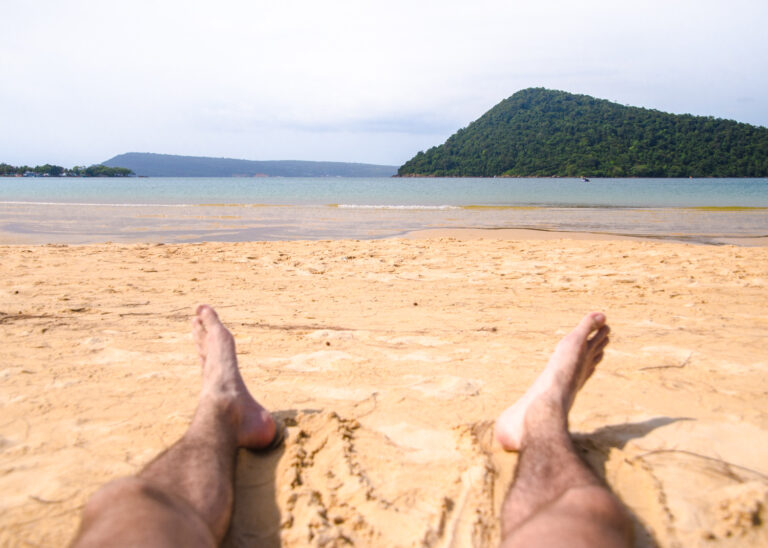
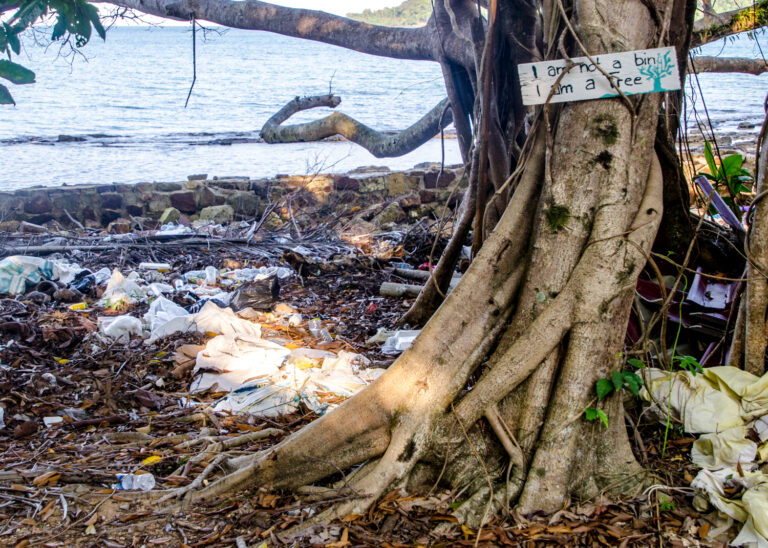
Days 10-12: Kampot & Kep
Where to stay:
- Best hostel: Onederz Kampot
- Best mid-range: Bamboo Bungalow
Day 10: Bus to Kampot
This morning, jump aboard a departing boat on Koh Rong Samloem (best book it at the office the day before to guarantee your place) and head back to the mainland.
Once you’re back in hell Sihanoukville, take a tourist bus to Kampot for around $10 and in 2 hours you’ll be there.
After that, its time for some late afternoon kayaking!
Mangrove forest kayaking
One of the best experiences in Kampot is kayaking through the mangroves not far from town.
Dump your bags at your hostel, rent a motorbike and head to Champa Lodge about 4km away. From here you can rent kayaks for $5 which is wonderful way to spend your first afternoon in Kampot.
Once you’ve got your kayak, slowly make your way through the dense mangrove forest known as the ‘Green Cathedral’ and see local fisherman and some traditional bamboo houses by the shore.
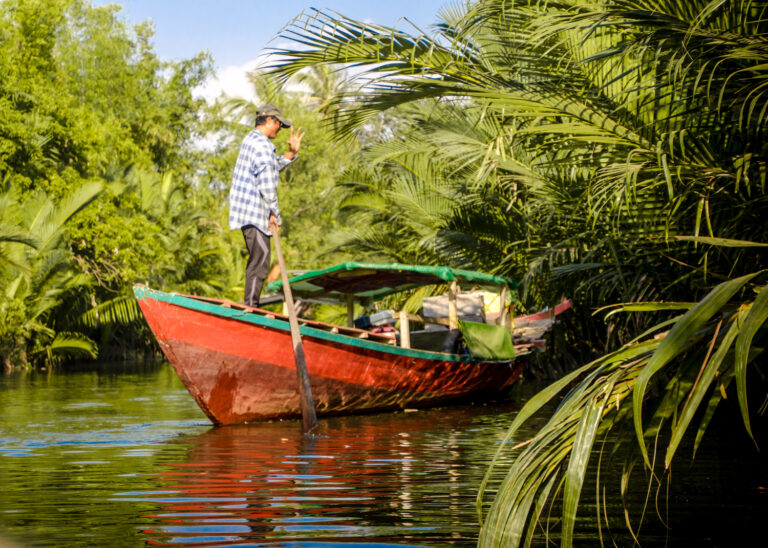
Set right on a bend in the river, the setting at Champa Lodge is simply stunning. If you time it right you’ll be just in time for sunset, but it’s beautiful at any time of day.
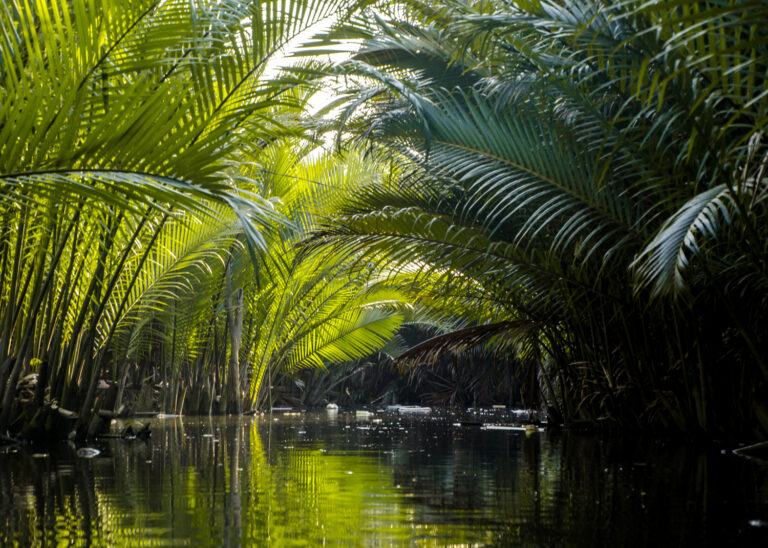
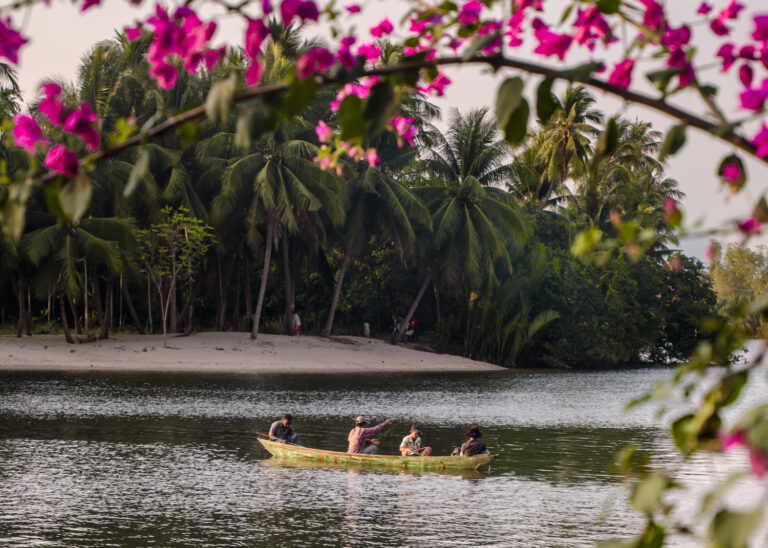
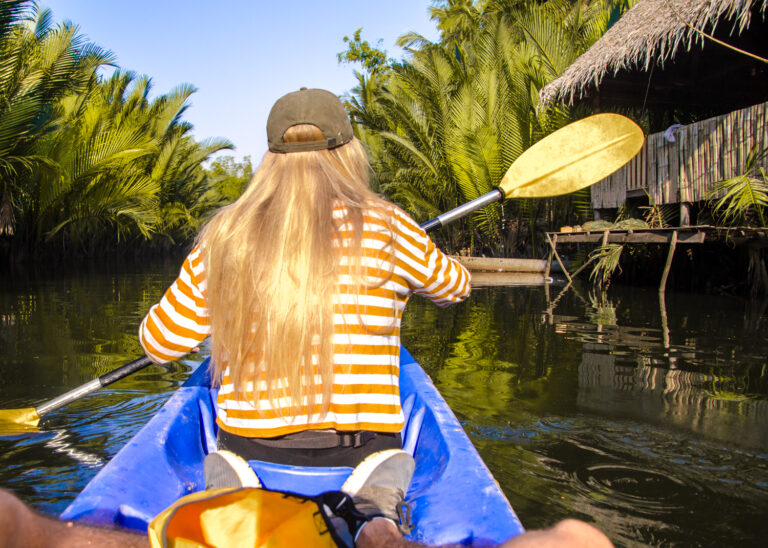
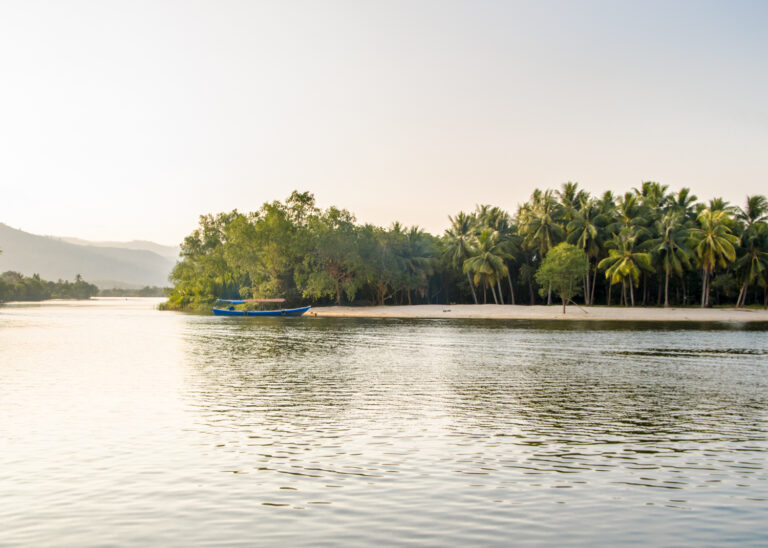
Afterwards, you could easily chill by the serene shoreline at Champa Lodge for hours. They have food and drinks for sale and some very picturesque views.
Everyone loves a palm tree at sunset!

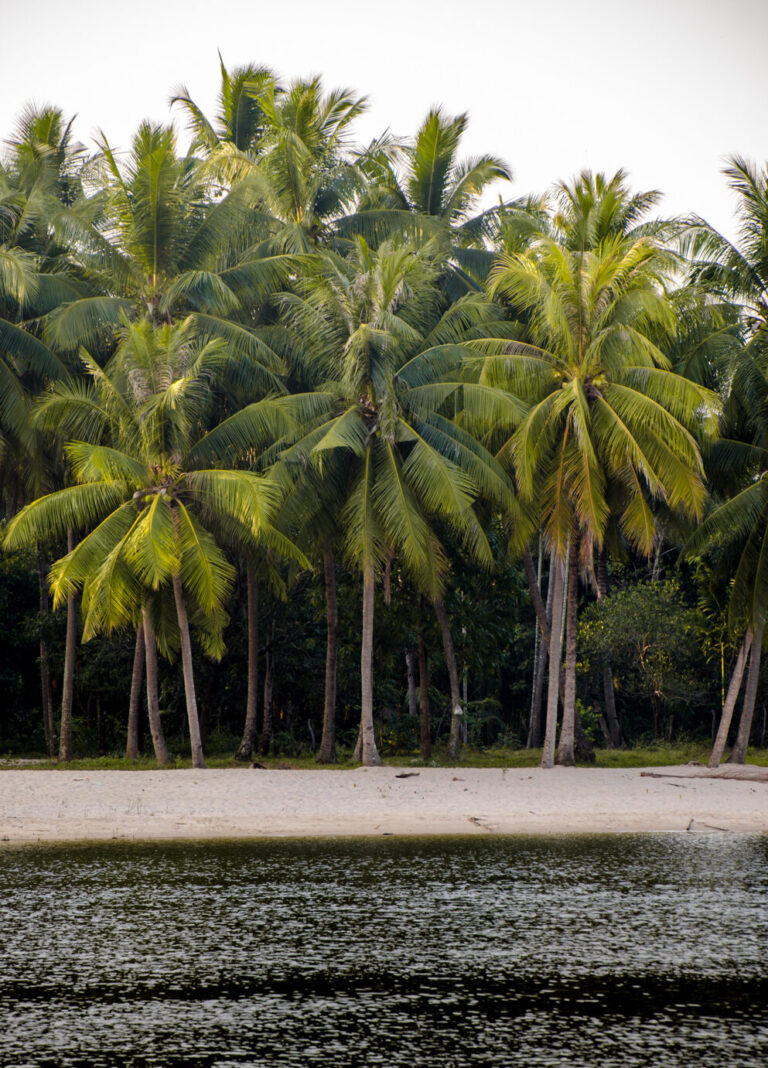
Day 11: Kampot countryside
Bokor Nayional Park
Mount Bokor is the 2nd highest mountain in Cambodia and the Bokor National Park is the great destination for a little road trip from Kampot.
Rising 1048 metres above sea level and just 1 hour (40km) away from Kampot, many buildings on the mountain have long been in a state of abandonment.
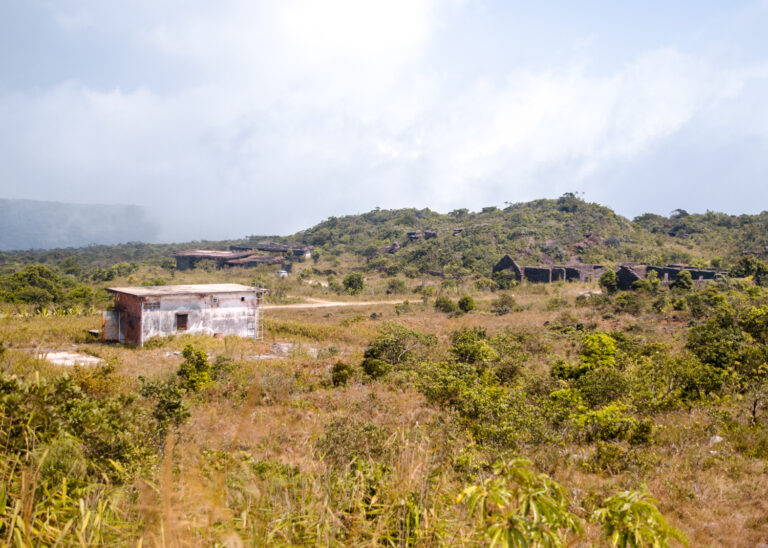
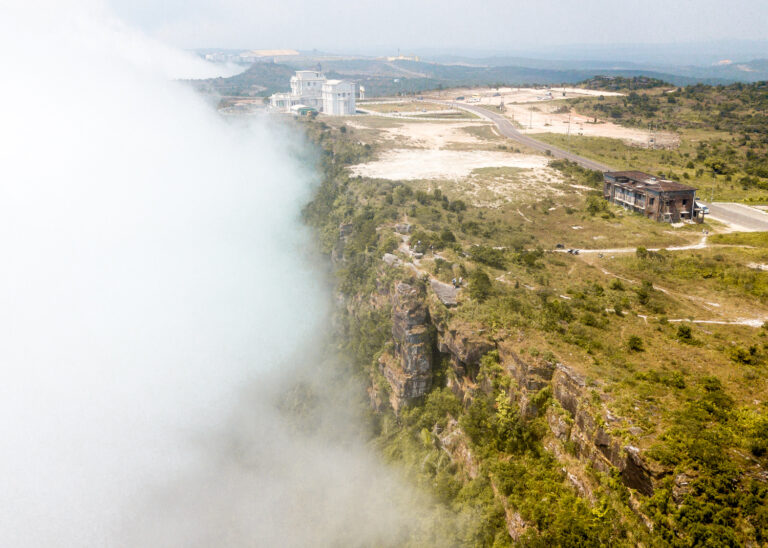
What to see on Bokor Mountain:
- Wat Sampov Pram
- Bokor Hill Station
- Lok Yeay Mao (a goddess in Buddhist culture)
- Le Bokor Palace hotel
- Abandoned buildings
- Popokovil Waterfall
You used to be able to enter the long-abandoned Le Bokor Palace and have a look around the derelect building, but as of 2018 it is back open again as a 5-star hotel.
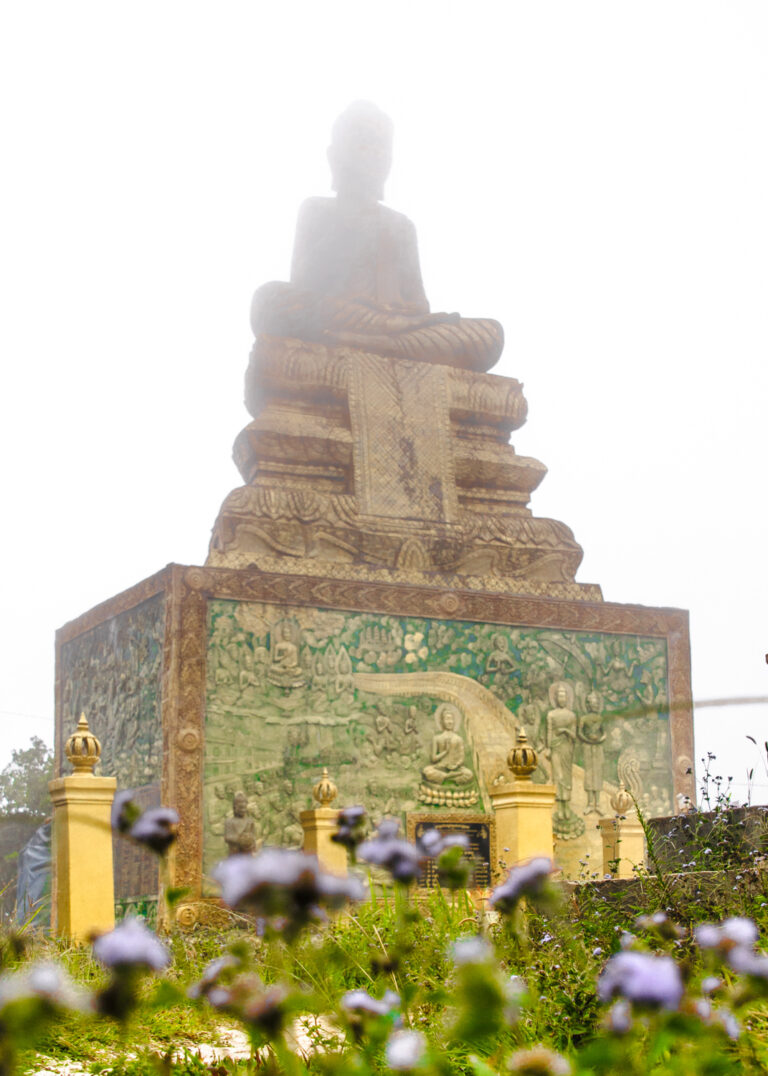
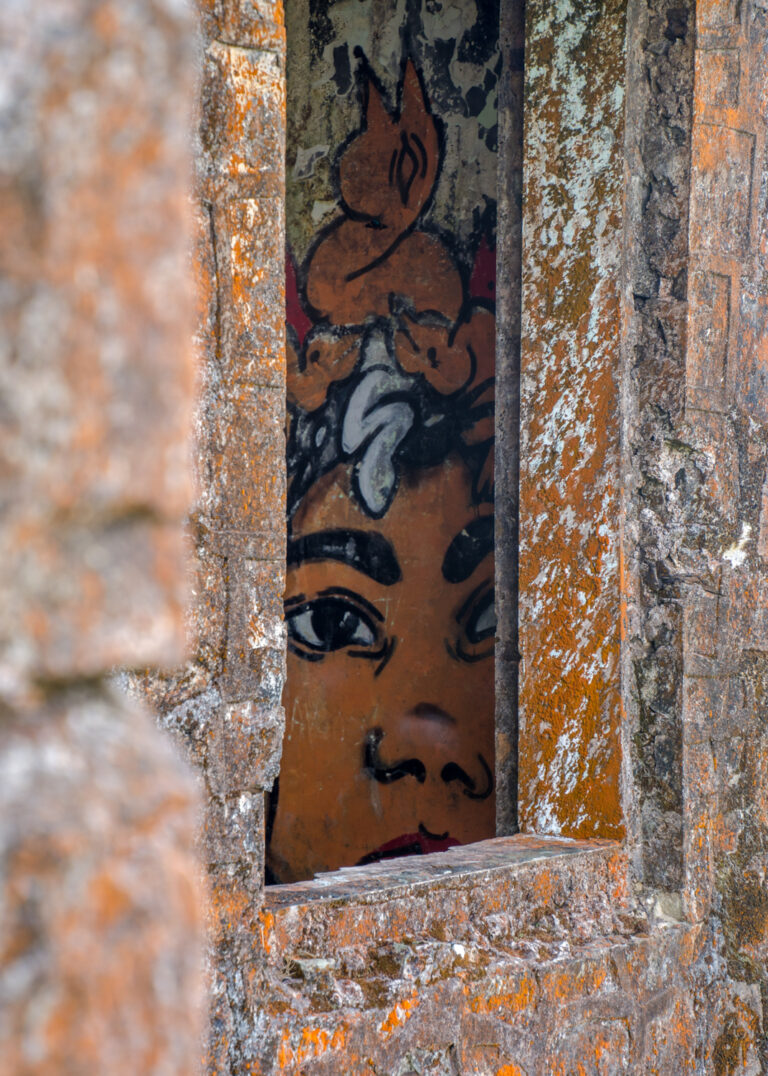
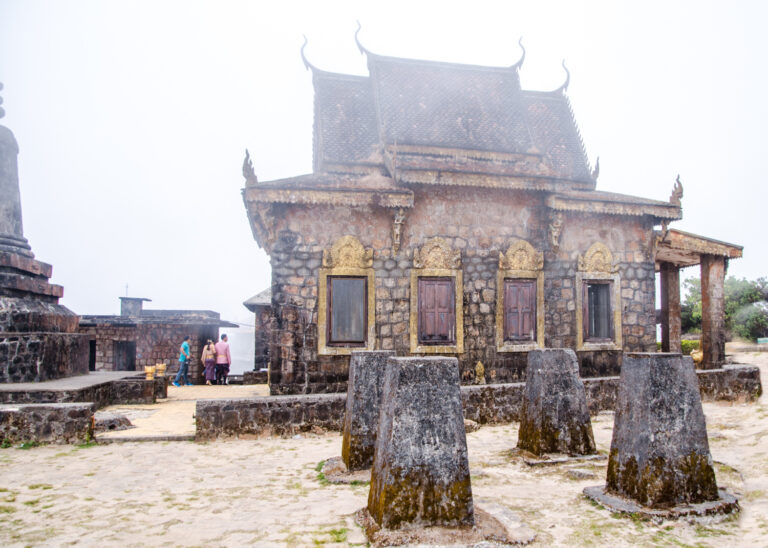
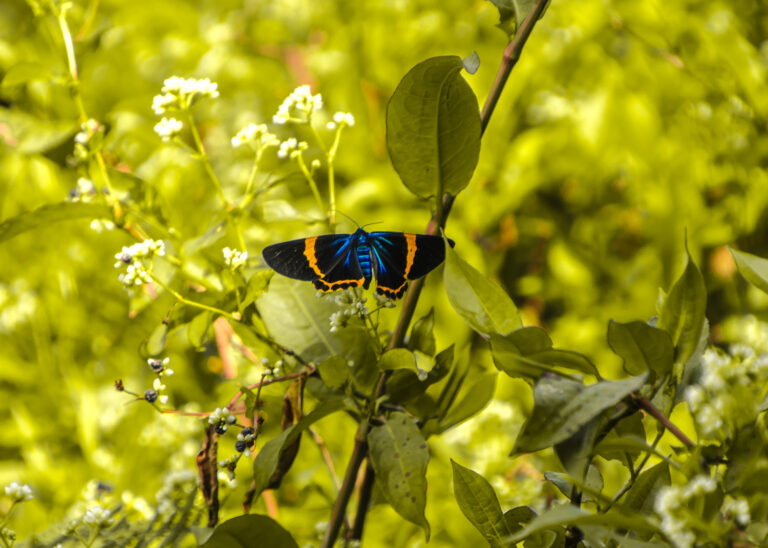
If you get lucky you’ll get an awesome view from the cliffs, but many people, like me, are met with thick fog.
Popokovil Waterfall is just 6km away, but don’t bother going in the dry season as it was completely dry when I visited. The waterfall was $1 including a free bottle of water.
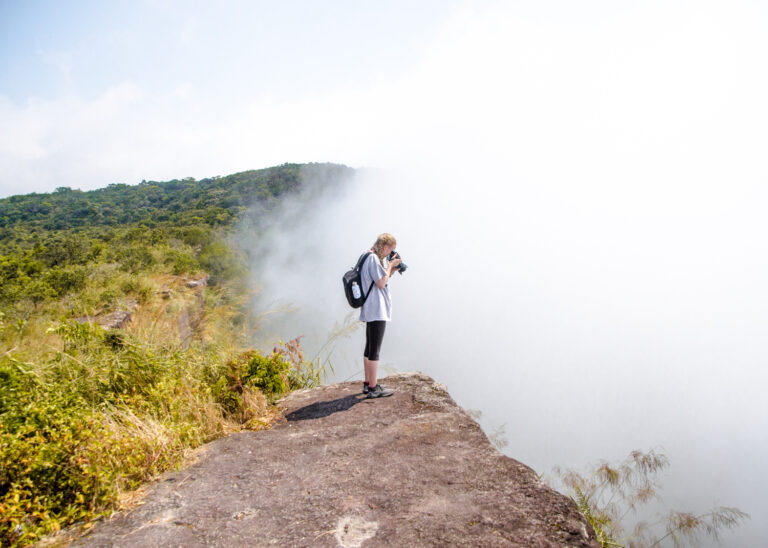
Day 12: Kep day trip
This morning, drive 45 minutes to Kep to spend your day in the small fishing town that’s famous for its fresh crab market.
With a nice beach and an interesting insight into local life, exploring Kep on foot is a great opportunity to spend a day somewhere that many travellers don’t go in Cambodia.
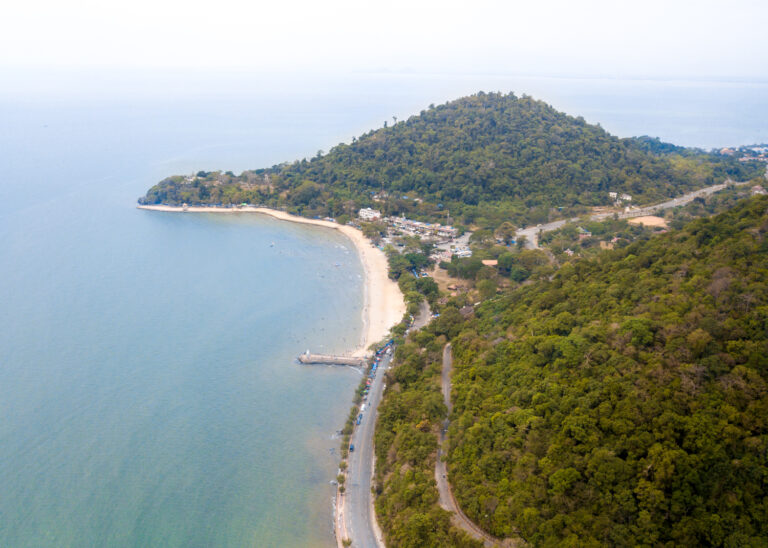
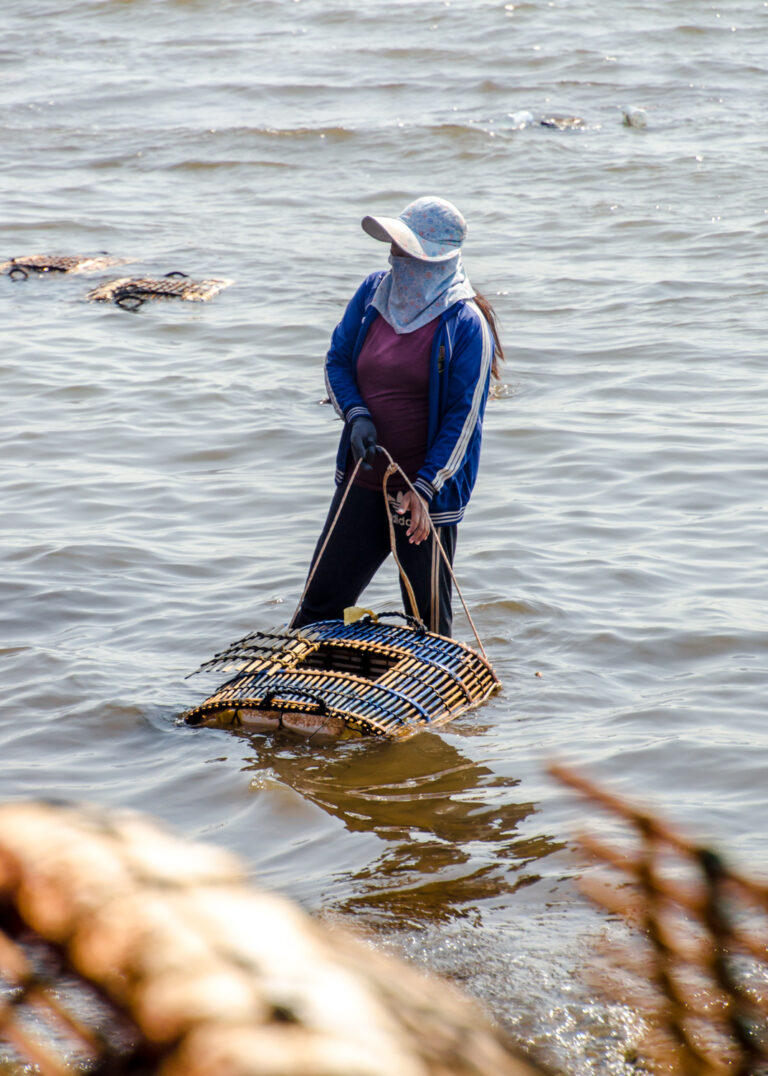
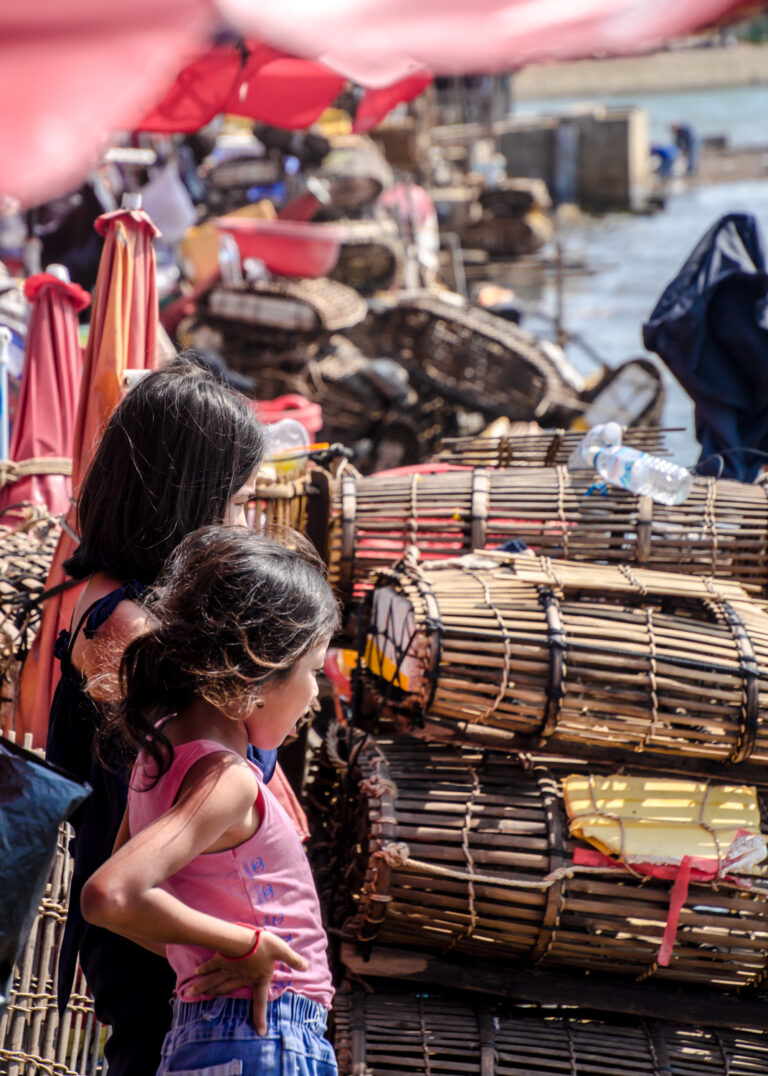
Most of the action revolves around the large crab market, where you can watch the locals go about their business. You can watch the full process from the people catching the crabs to putting them on the table for sale immediately – it doesn’t get any more fresh than that!
Have a nosy at the mansions that have been abandoned since the Khmer Rouge regime, eat a fresh seafood lunch from one of the many restaurants along the shoreline and check out Kep National Park while you’re here, where there are various viewpoints.
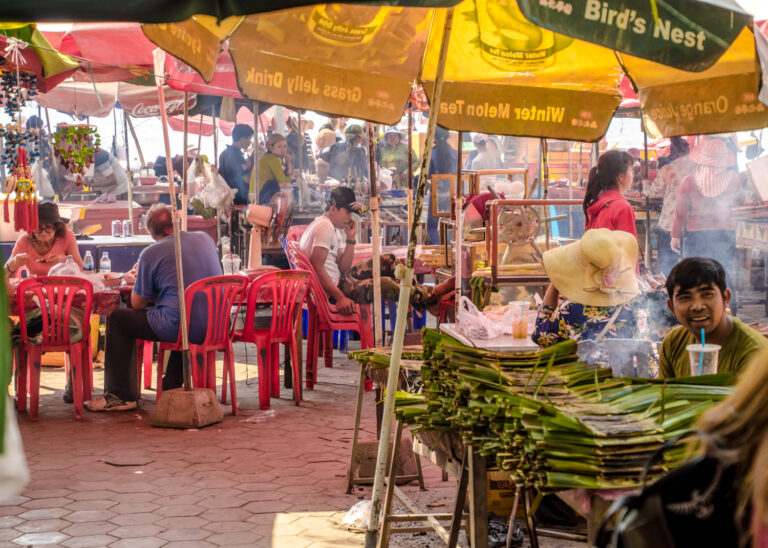
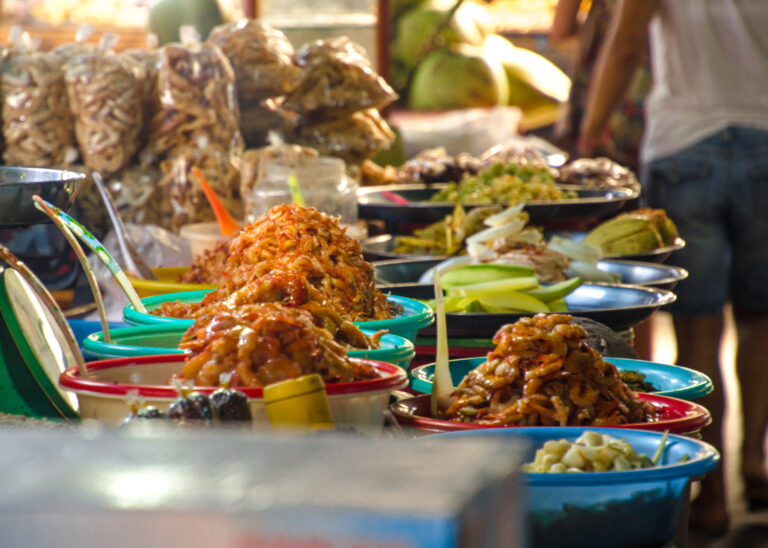
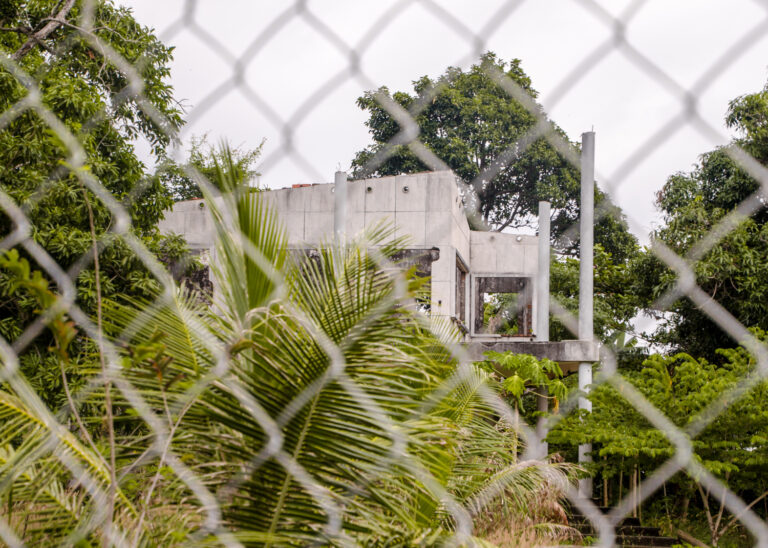

You can’t leave Kep without taking a photo of the epic crab monument out at sea!
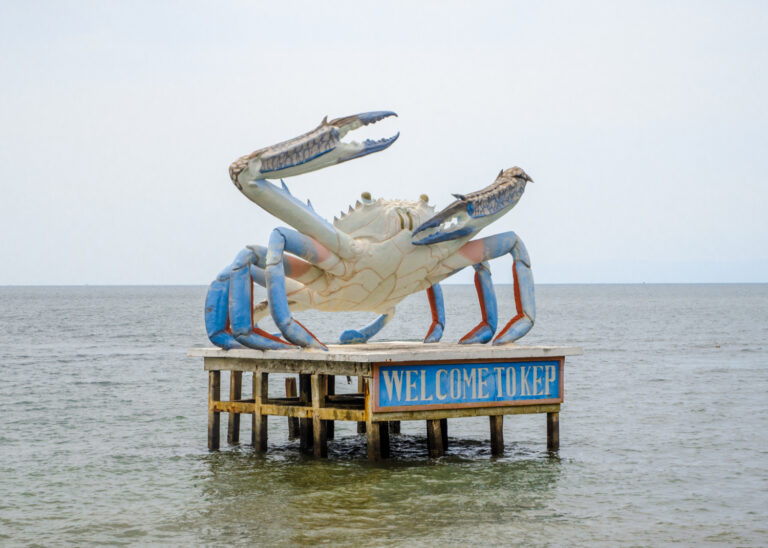
Days 13 & 14: Phnom Penh
Phnom Penh is the capital city of Cambodia and to get here you’ll need to take a 3-4 hour bus which is super easy to organise from Kampot.
Book your Kampot to Phnom Penh tickets here for just $10 USD
This quintessential southeast Asian city has a fast-paced vibe and is packed crazy streets, interesting culture and cool things to see and do. That said, Phnom Penh is plagued by a dark past and no visit is complete without learning about the atrocities of the Cambodian Genocide.
Where to stay:
- Best hostel: Nangkol Village
- Best mid-range: Queen Mansion
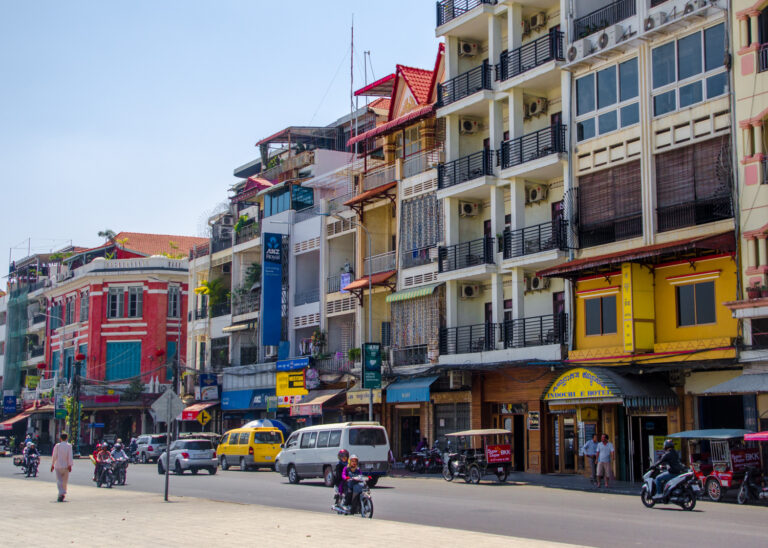
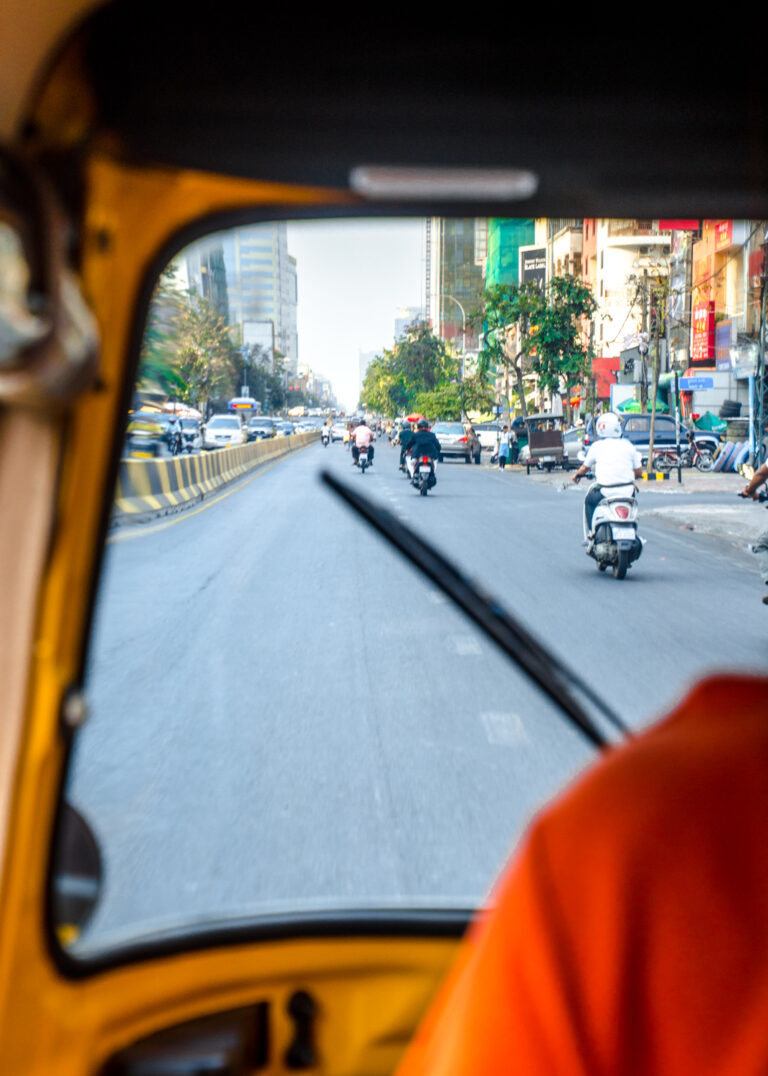
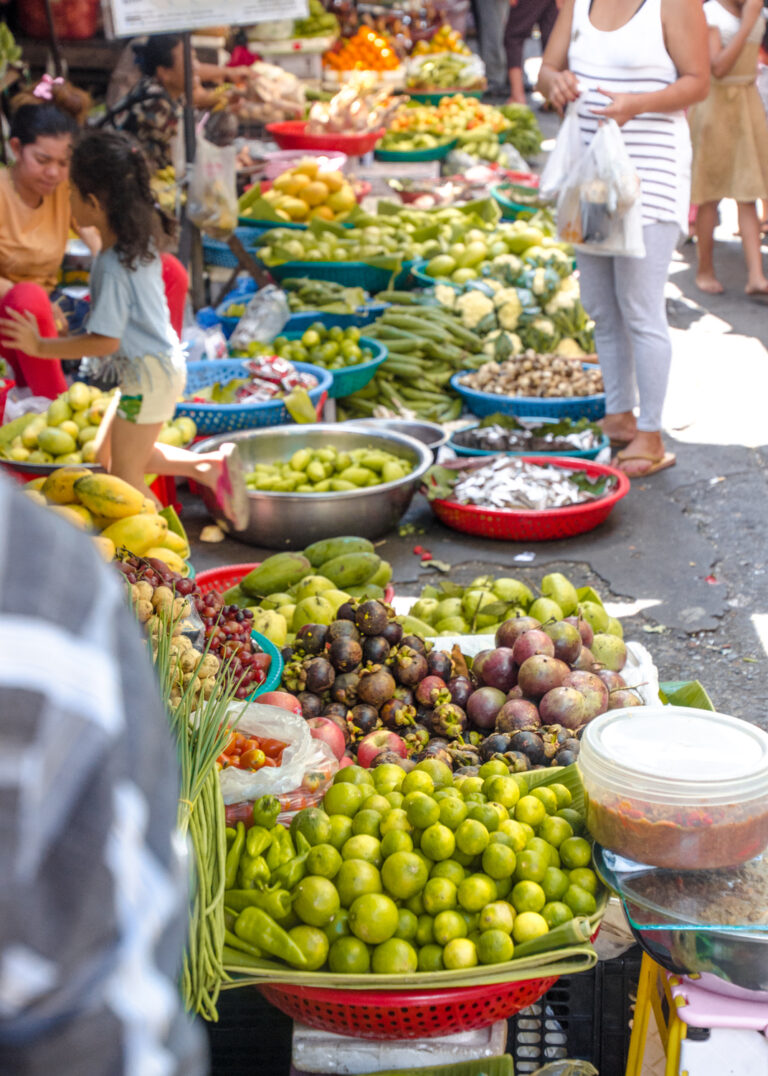
Day 13: Combodian Genocide Sites
S21 Genocide Museum
Once a high school, Tuol Sleng Genocide Museum was used as a prison camp during the Khmer Rouge era and today houses exhibits about the country’s violent past.
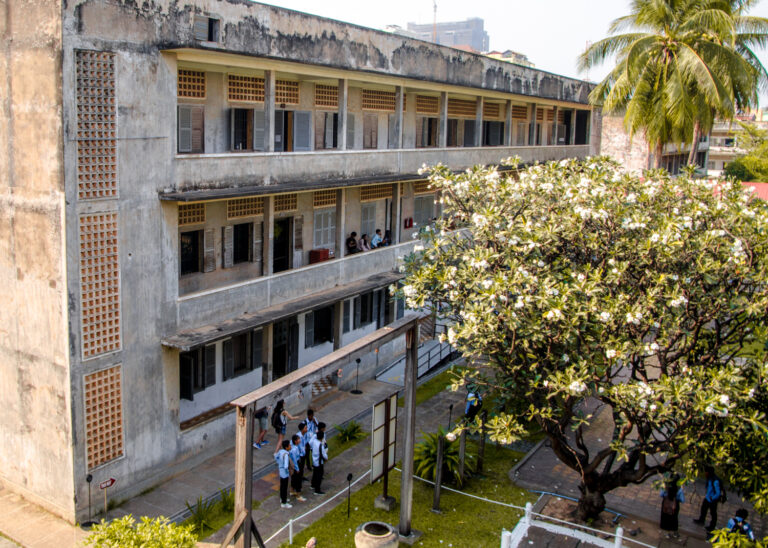
Prisoners endured various methods of torture and interrogation throughout their stay at Tuol Sleng, like waterboarding, electric shocks, acid showers and fingernail removal.
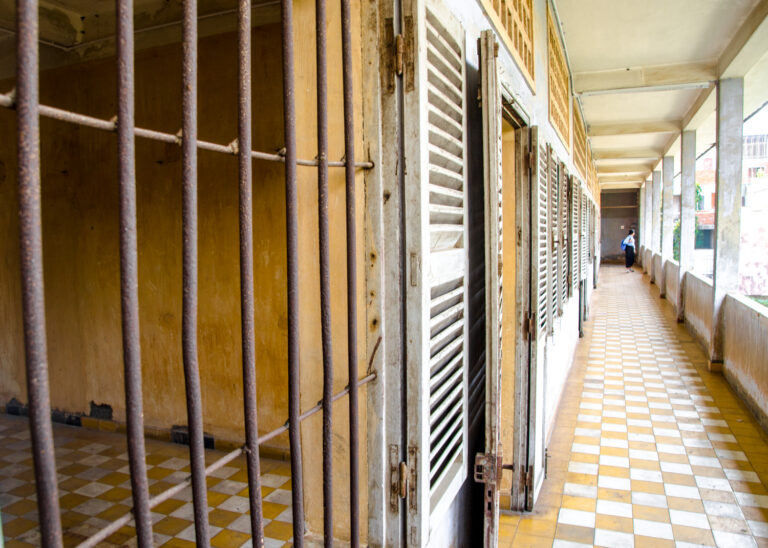
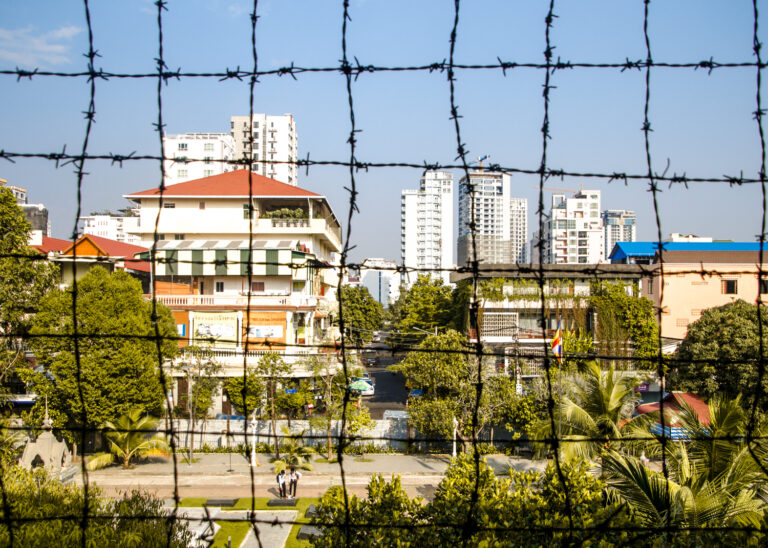
Similar to the Nazis, the Khmer Rouge meticulously photographed every single person who entered S21 and kept records for the prisoners. The walls are covered in pictures of the inmates and some incredibly vivid photos and paintings depicting the torture, most of which were actually captured by the Khmer Rouge themselves!
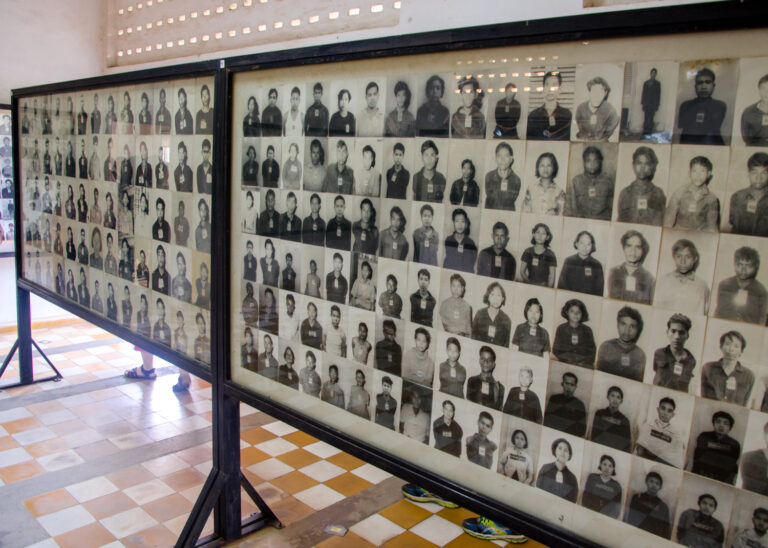
The Killing Fields of Chueong Ek
About 30 minutes from downtown Phnom Penh lie the infamous Killing Fields of Choeung Ek.
Order a Grab for a few dollars and explore the area with an audio guide for $6.
What happened here really has to be seen to be believed.
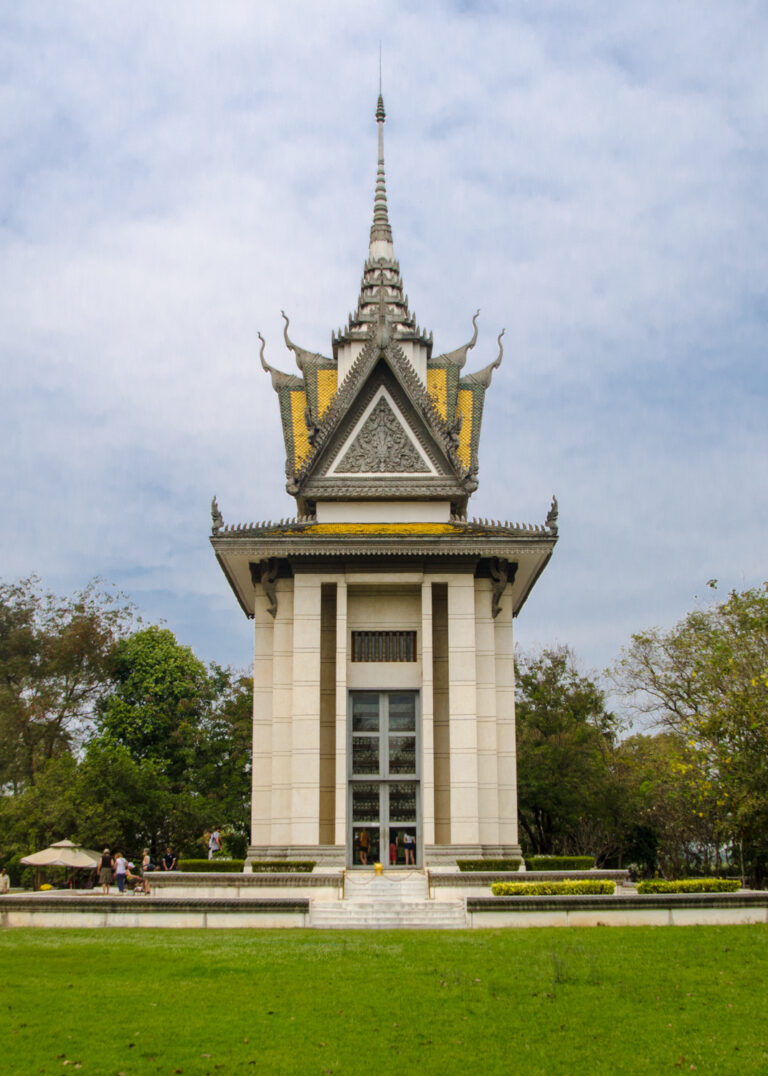
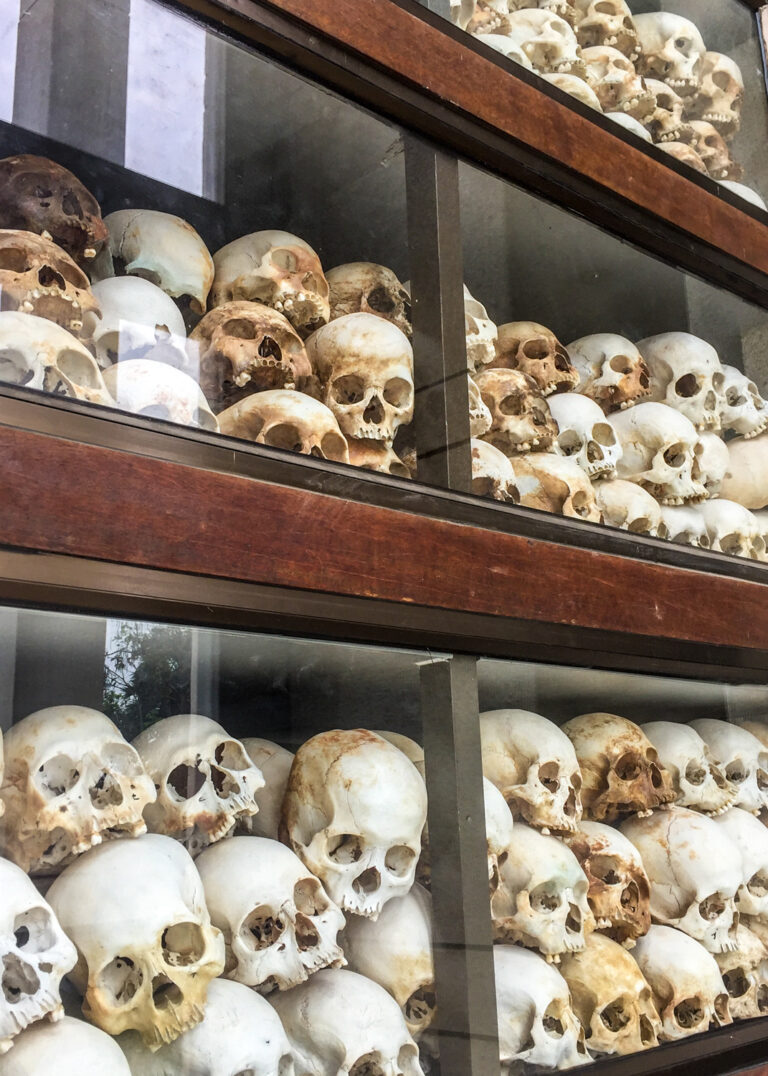
The Khmer Rouge didn’t use guns to execute people because bullets were too expensive, so they used things like spades, farming equipment, hammers and knives instead. You can see the damaged skulls of close to 9,000 victims in the Memorial Stupa above.
In the relatively small area nearly 20,000 people were discovered in 129 mass graves, however 43 of those graves have been left untouched so to not disturb their peace.
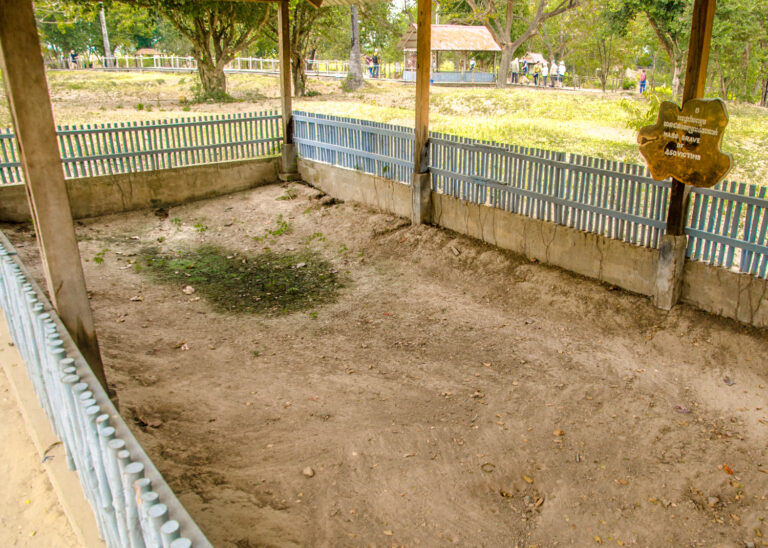
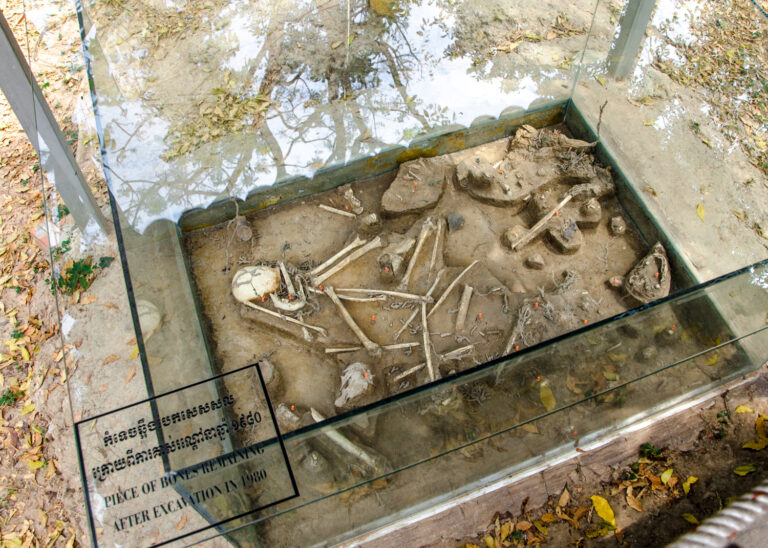
Of all the horrendous things to see, “the killing tree” is the most unreal.
The Khmer Rouge would pick up babies an children and swing them by their feet, hitting their heads off the tree until they were dead. Their bodies were then thrown into unmarked mass graves and buried.
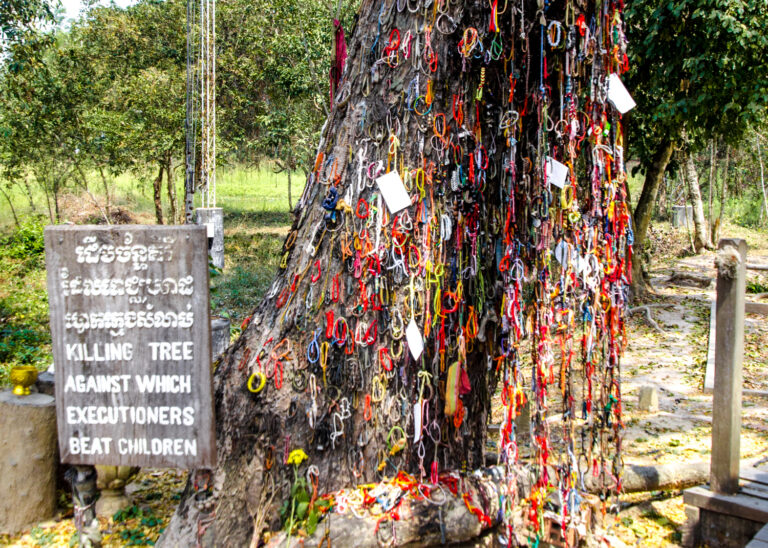
The area is small, but there is plenty to see at Choeung Ek to spend a couple of hours in your feels, learning about the poor Cambodian people who suffered under the Pol Pot regime before heading back to the city for the night.
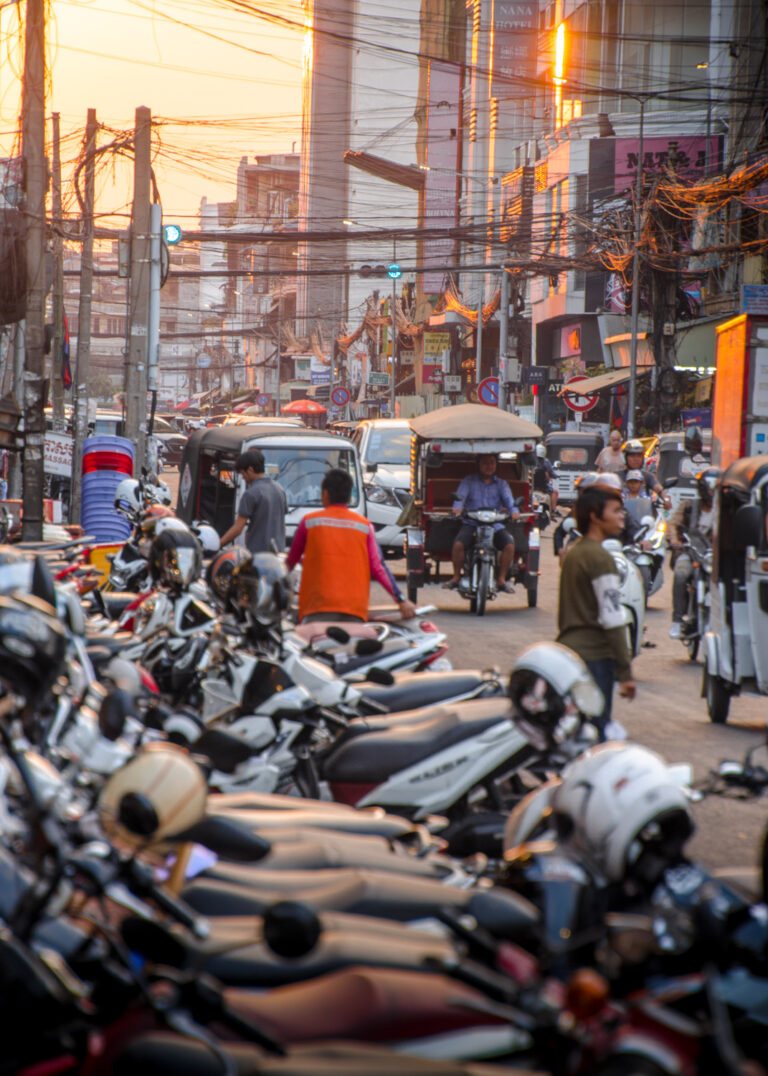
Day 14: Exploring Phnom Penh
Wat Phnom
On top of a small hill, marking the location where Phnom Penh was officially founded, is Wat Phnom.
It is the largest temple in the city and also it’s oldest structure, constructed back in 1373.
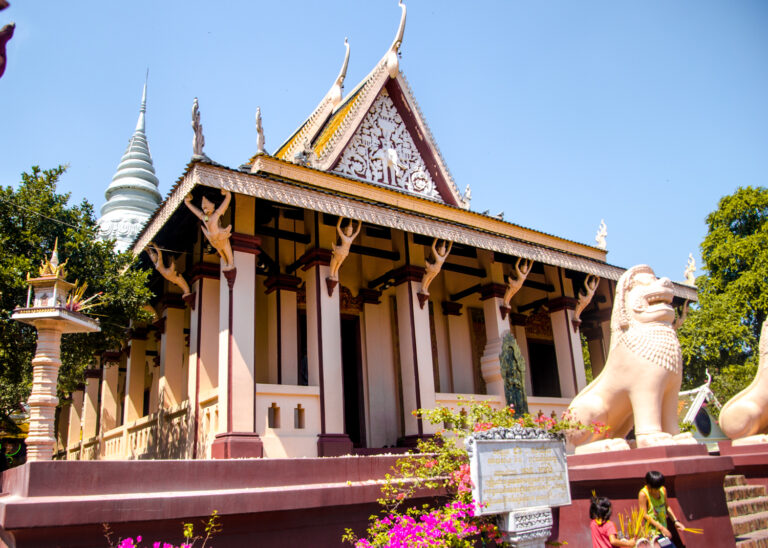
Royal Palace
Explore more of Cambodia’s history at the Royal Palace, the place where the royal family still live.
Built in traditional Khmer style, the former king was kept prisoner by the Khmer Rouge here and the nearby Silver Pagoda is worth a stop too. It is decorated with around 5,000 silver tiles weighing 6 tonnes!
Wat Ounalom
One of the city’s original and most loved pagodas, Wat Ounalom is near the Royal Palace.
It used to be a library and was once home to hundreds of monks permanently.
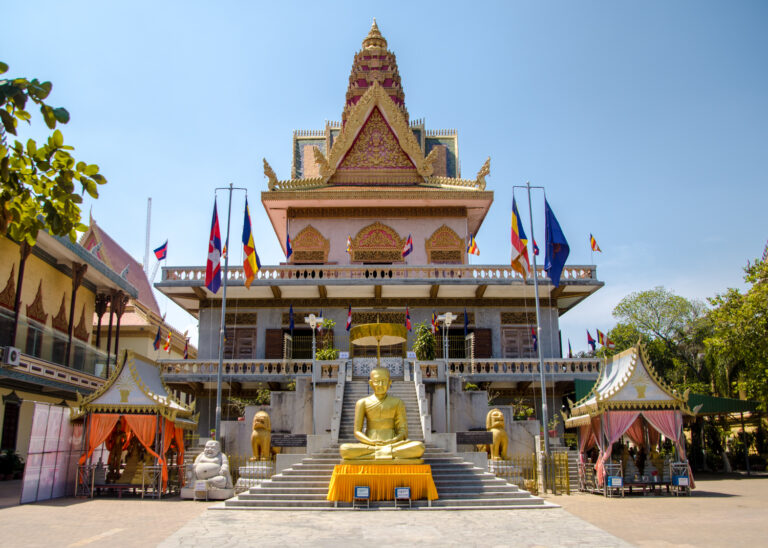
Independence Monument
The Independence Monument in Phnom Penh represents Cambodia’s independence from France in 1953 and is a pretty cool structure in the centre of a busy roundabout.
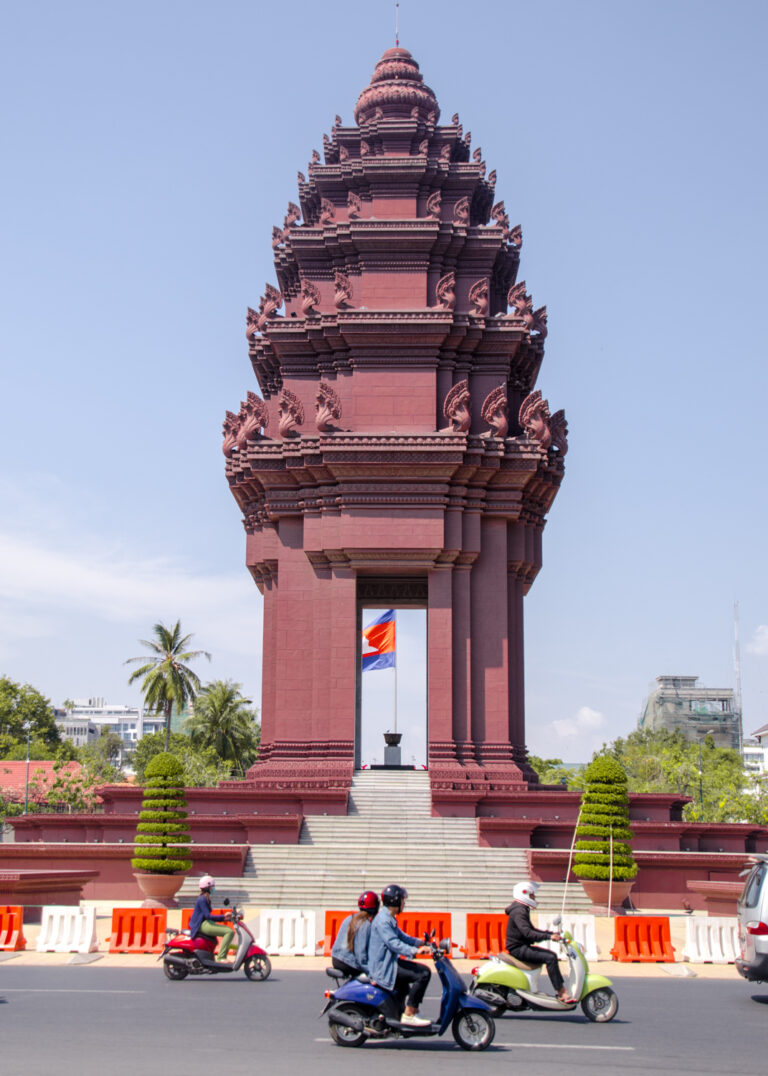
Central Market
Do some bargain hunting on your last day in Cambodia at Central Market, once the largest market in Asia.
There are stalls and vendors outside the building, but inside is where the main hall is found. A domed roof sits 26 metres above the market, which is packed with alleyways and affordable goods.
Even if you don’t plan on buying anything, it’s worth a trip just to stroll through!
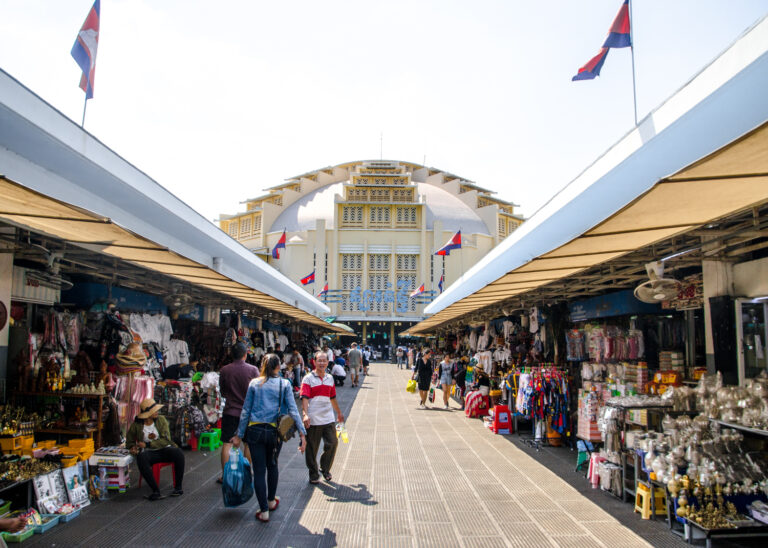
My experience in Cambodia
I travelled to Cambodia for 17 days in February 2019 and came away with mixed emotions overall.
In general, I really enjoyed my time there. Angkor Wat is obviously a big tick off my bucket-list and truly lived up the hype, Kampot was an awesome little place and I quite liked Phnom Penh despite the amount of people who don’t enjoy it there.
There were a few aspects about my experience that I didn’t enjoy as much as I thought I would though, namely the absolute state of Sihanoukville and general price of things in the country. Overall it’s a bit more expensive than neighbouring countries like Vietnam and Thailand, albeit not by much, but enough to feel ‘expensive’. The pollution around the country was pretty terrible too, especially on Koh Rong Samloem, which was sad to see but expected, I guess.
I would definitely return to Cambodia at some point, and in fact I nearly did in 2022! Everyone/everywhere deserves a second chance.
How much did I spend?
- Buses £82 (£41 per person)
- Accommodation £201 (£100 per person)
- General £795 (£398 per person)
- Total: £1078 (£539 per person)
Cambodia packing essentials
Best tours in Cambodia
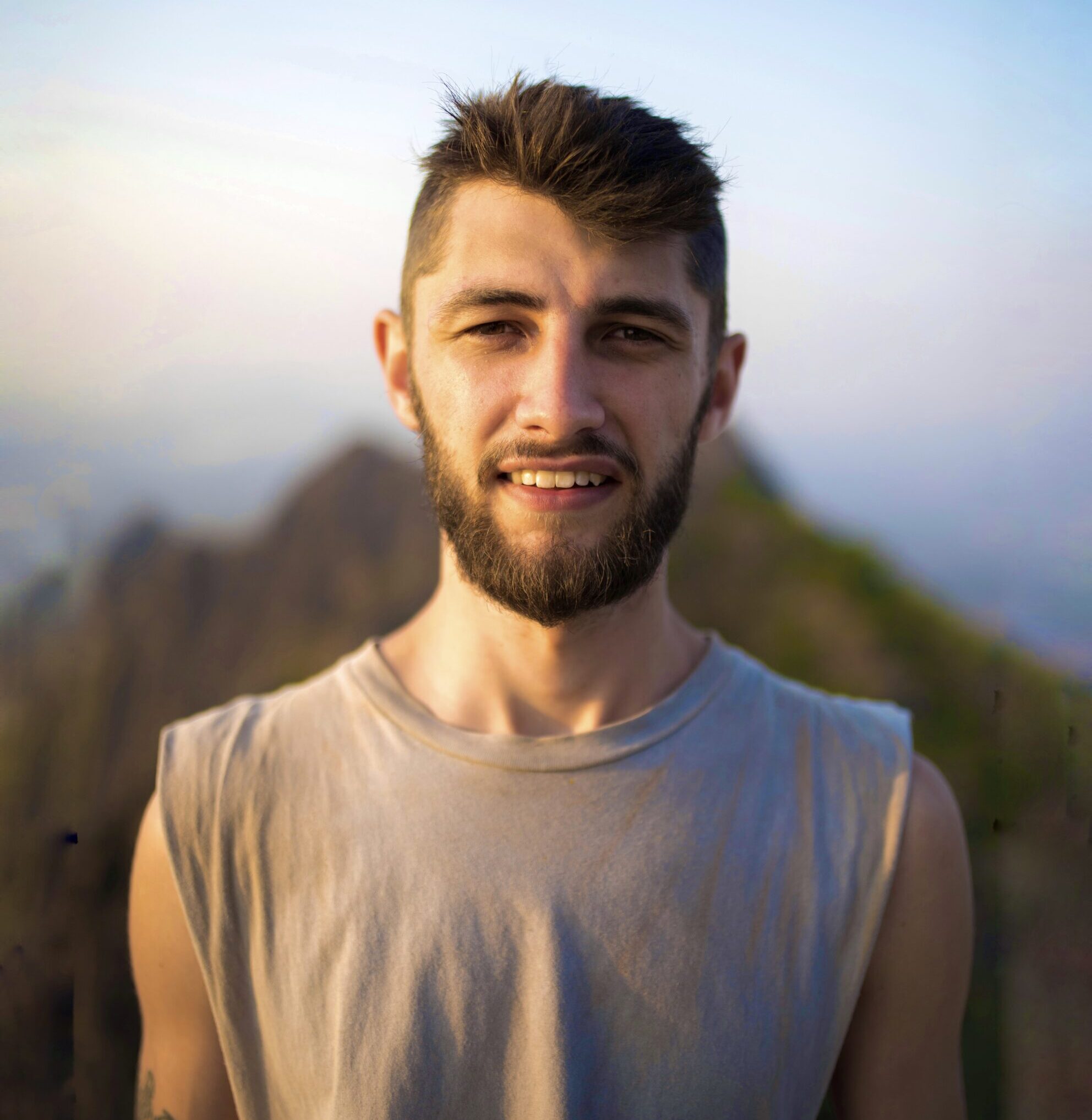
Thank you for reading this travel guide – I hope you found it helpful! Feel free to leave a comment below if you have any questions and I’ll get back to you as soon as possible
Happy travelling!
HELPFUL RESOURCES FOR PLANNING YOUR TRIP
Accommodation: Booking.com, Hostelworld
Tours: GetYourGuide, Viator, Klook, TripAdvisor
Transport: 12Go, Omio, Trip.com, Rome2Rio
WHO IN THE WORLD IS JAMES?
Click below to learn more about my story, including 5 random facts about me, some travel FAQ’s and my entire travel history.
